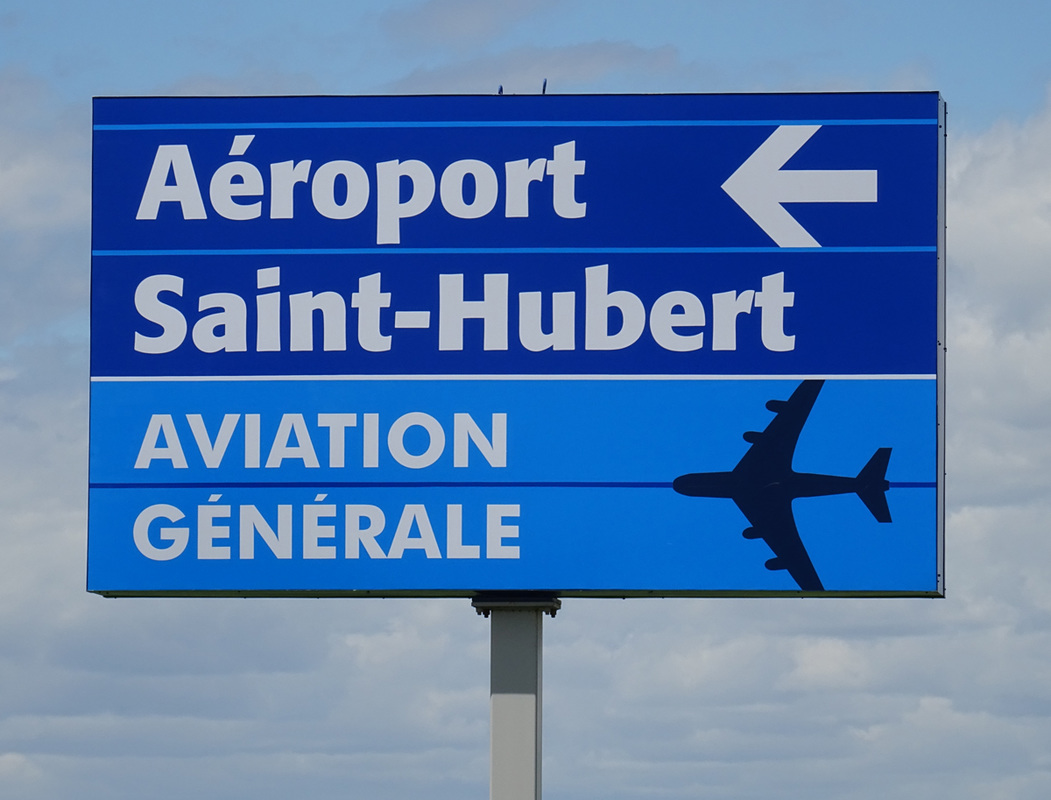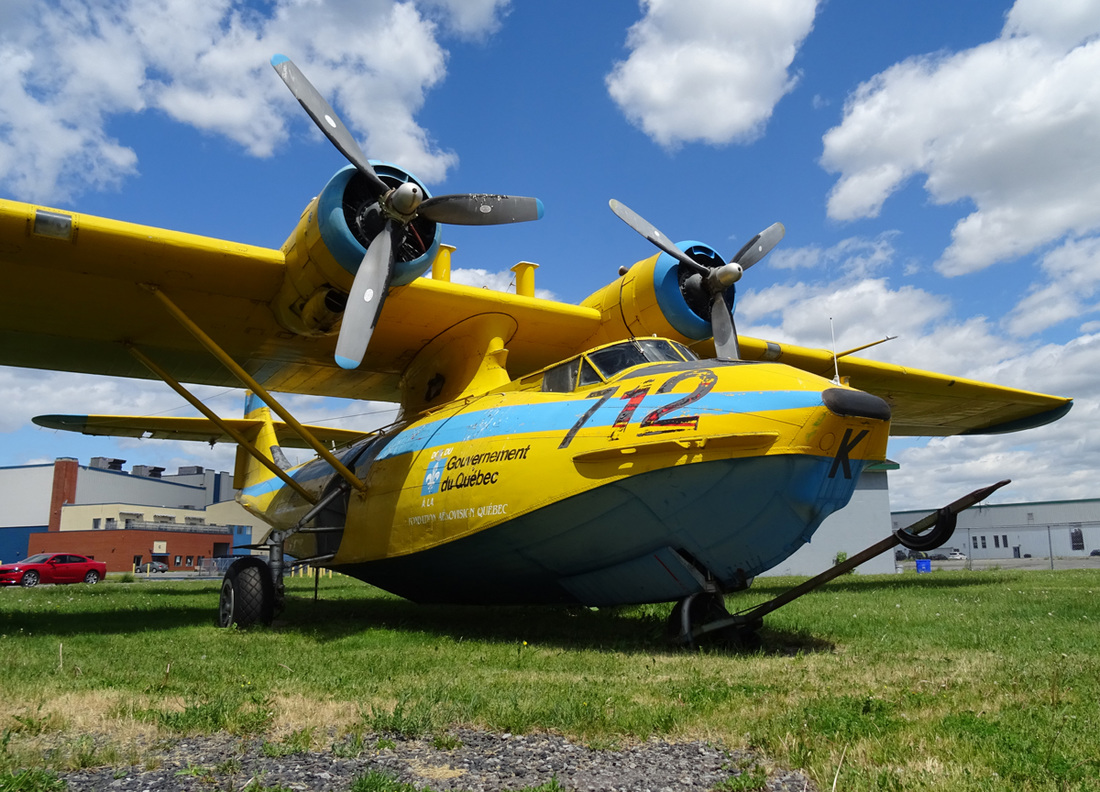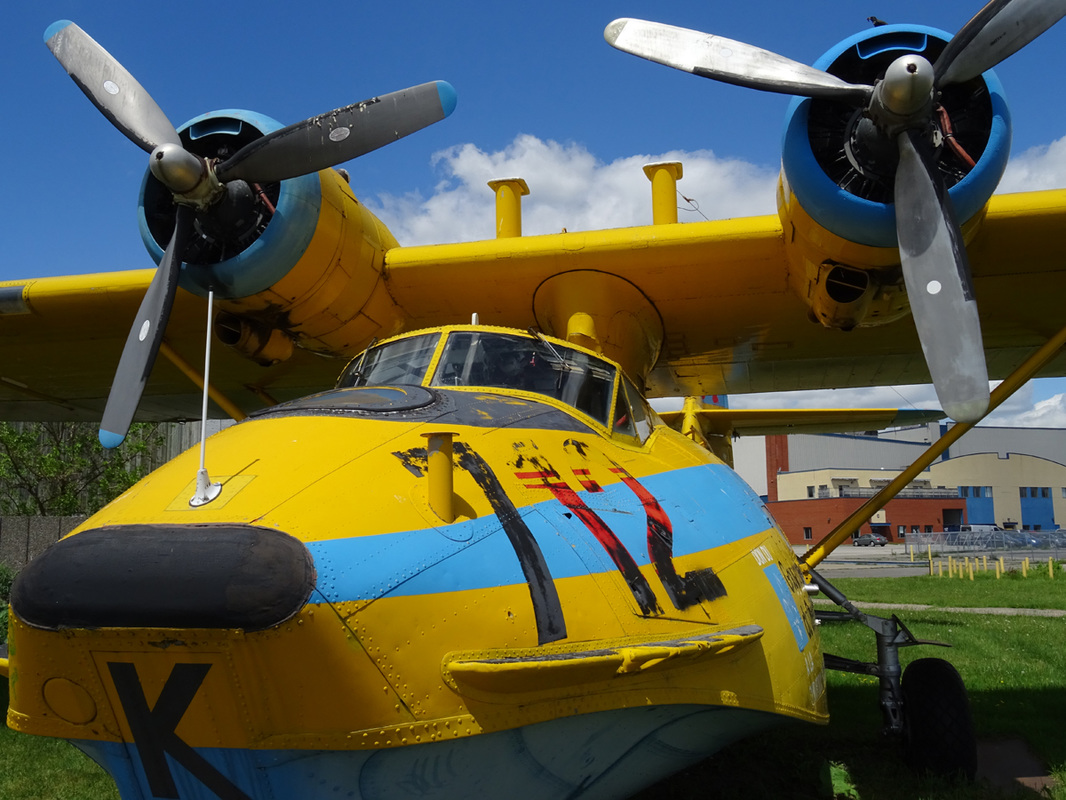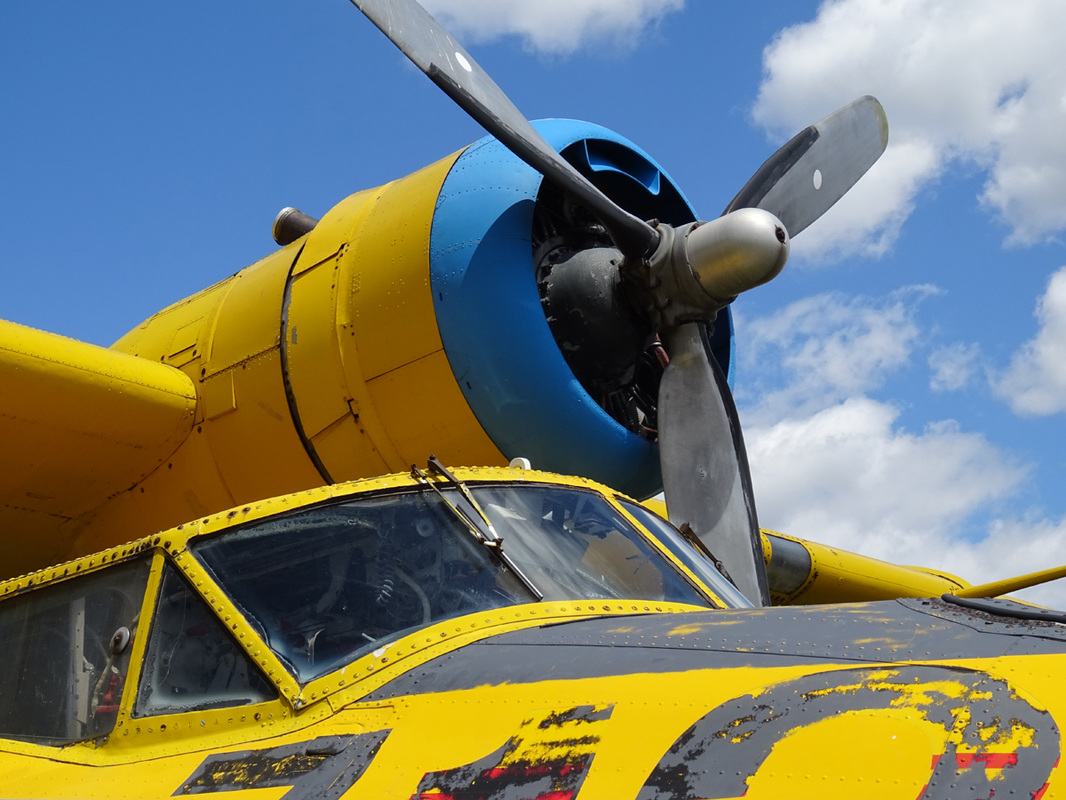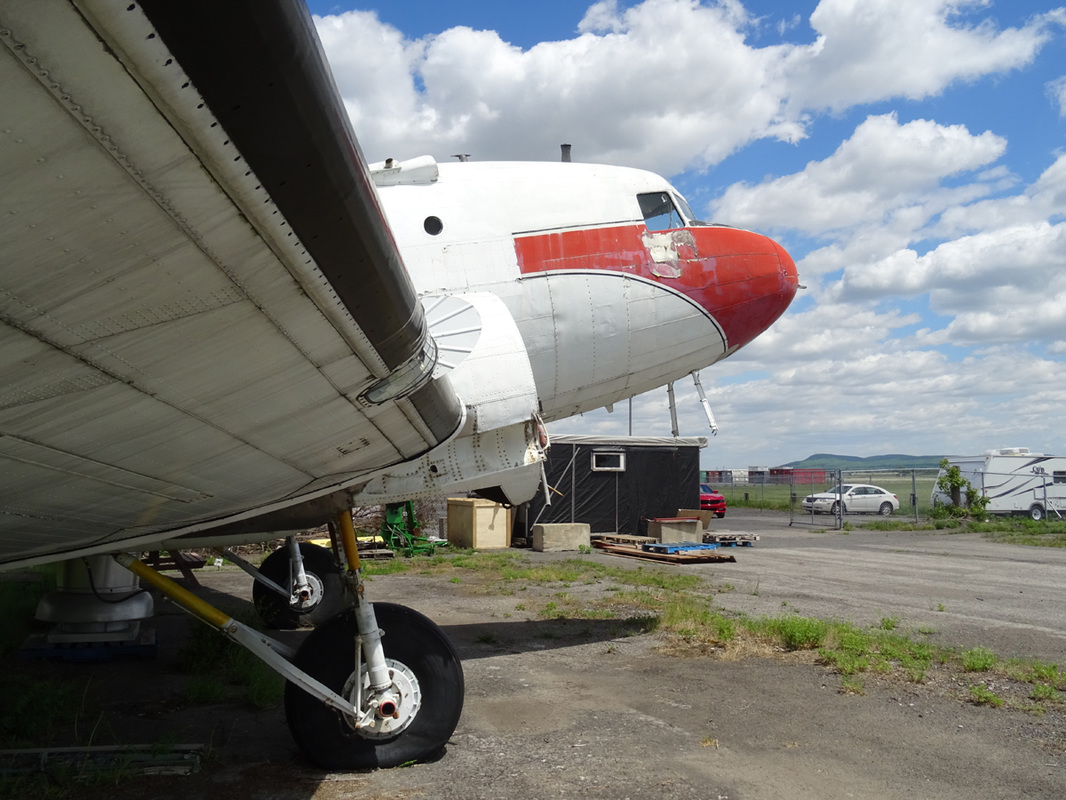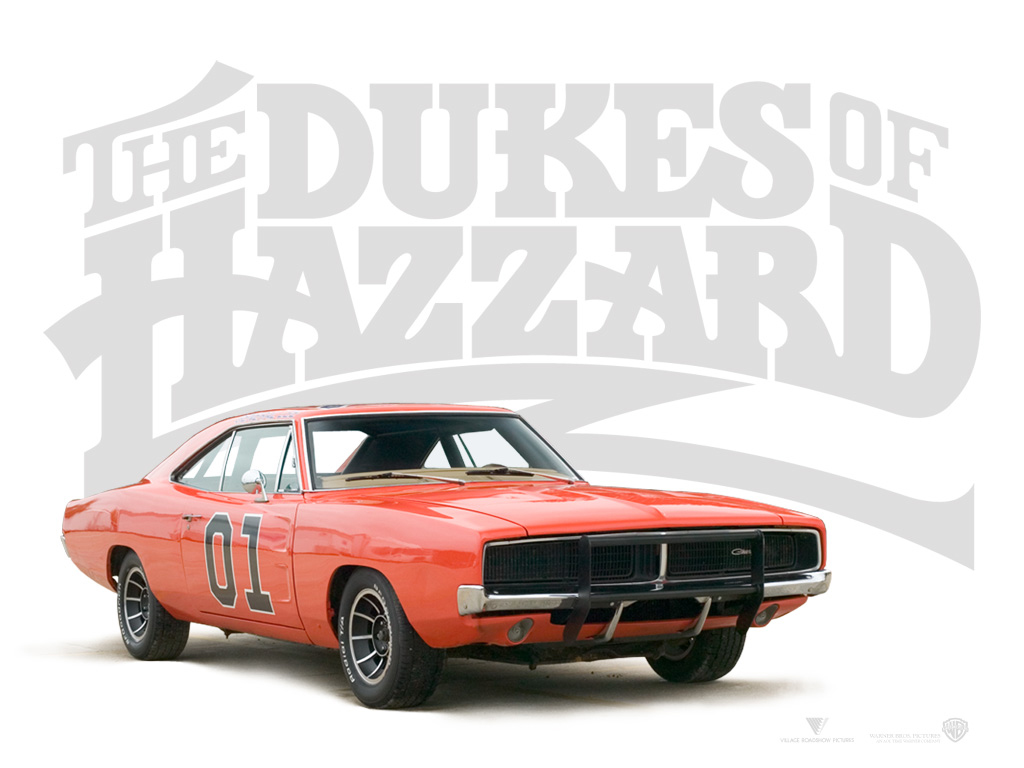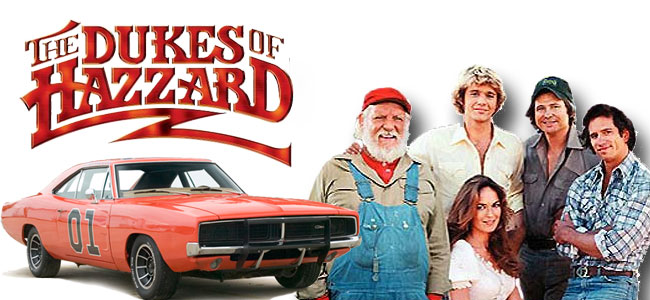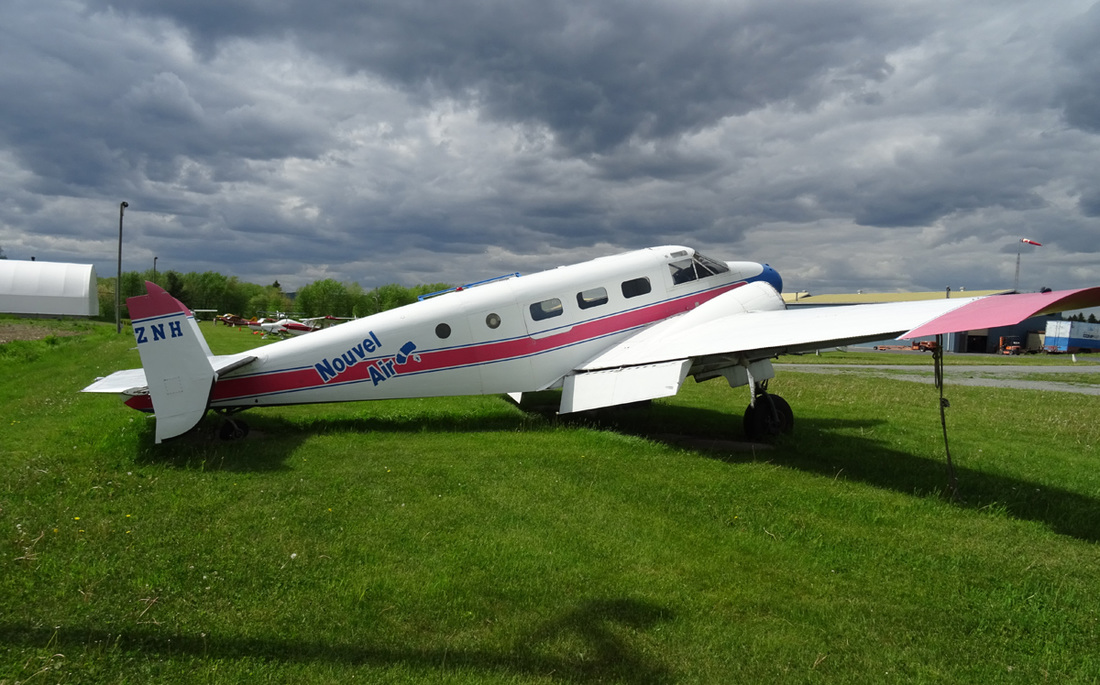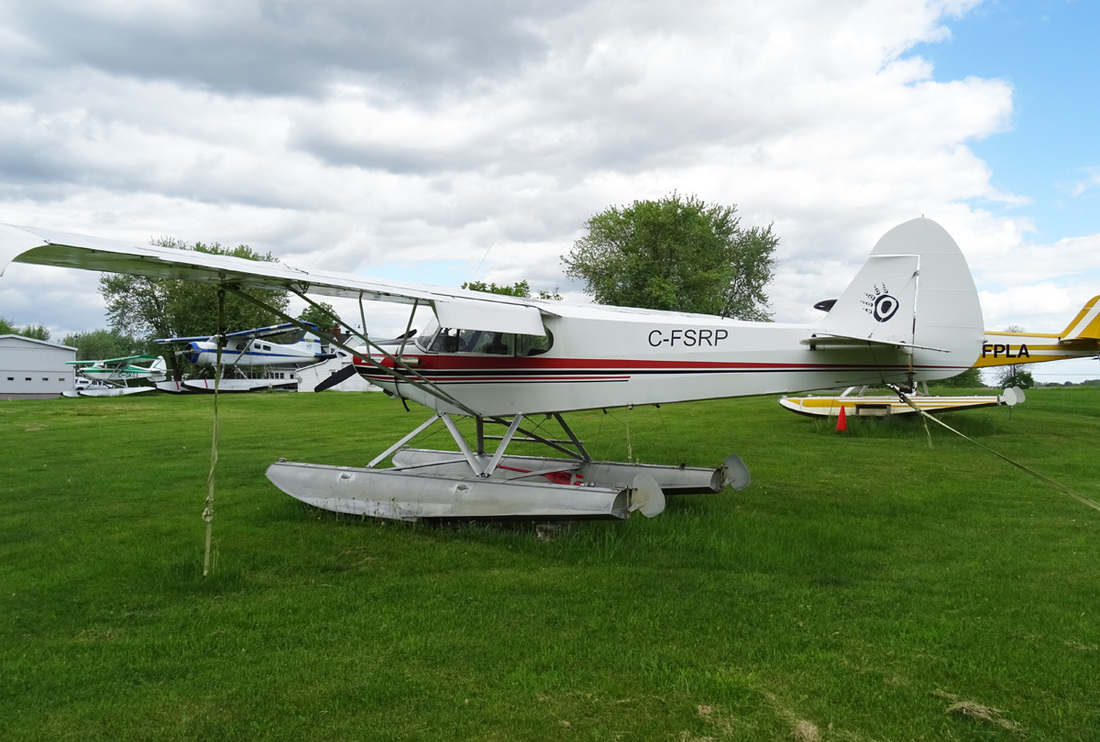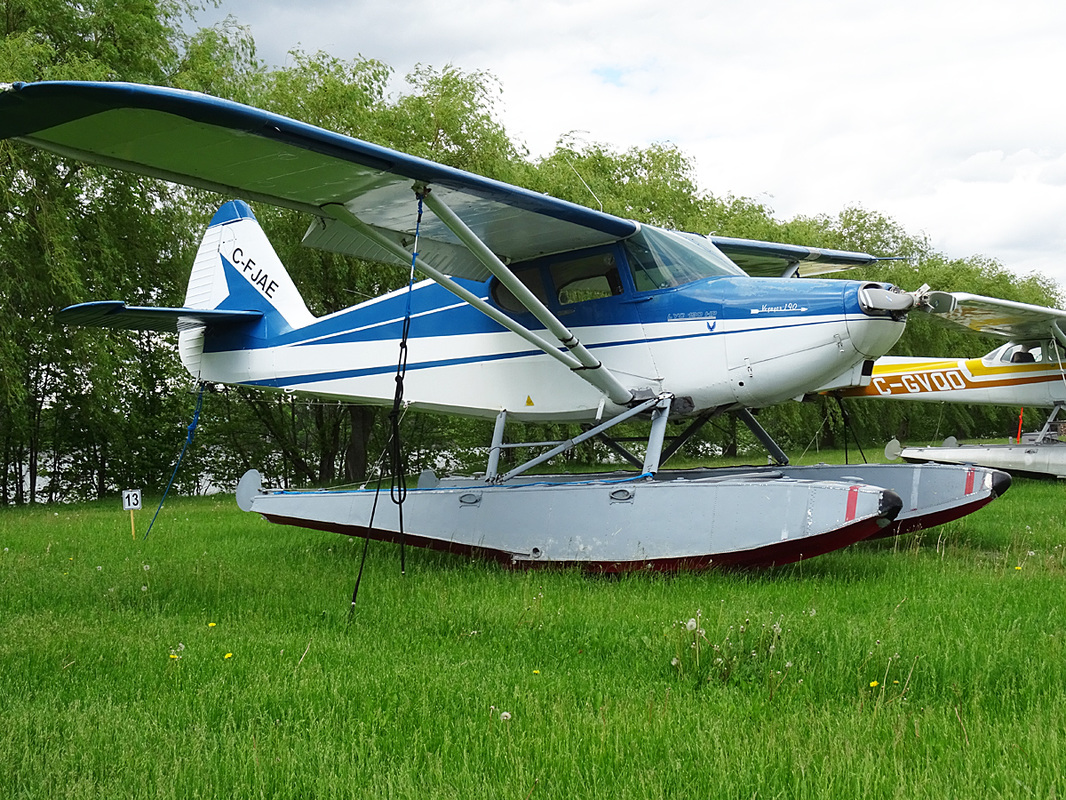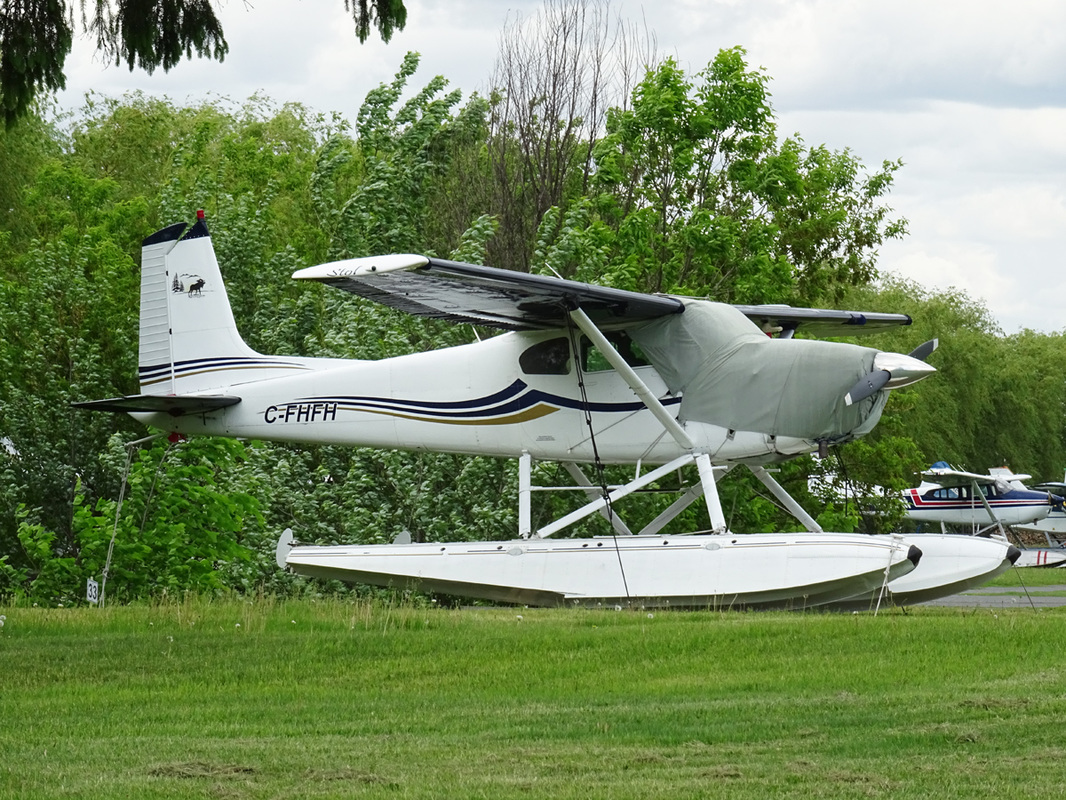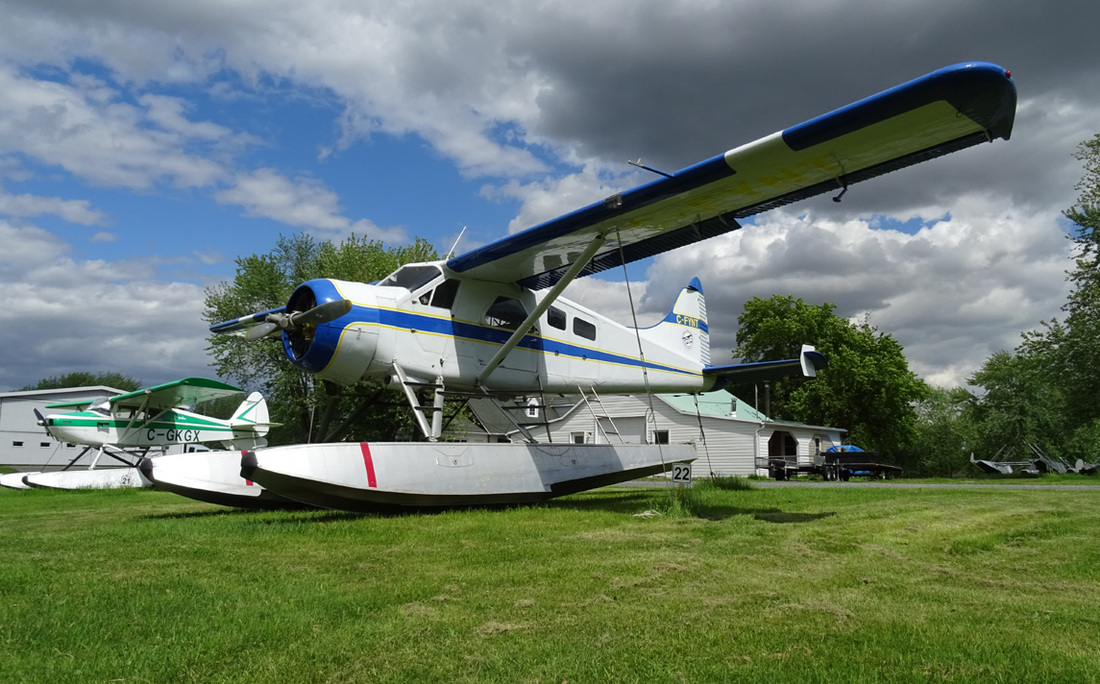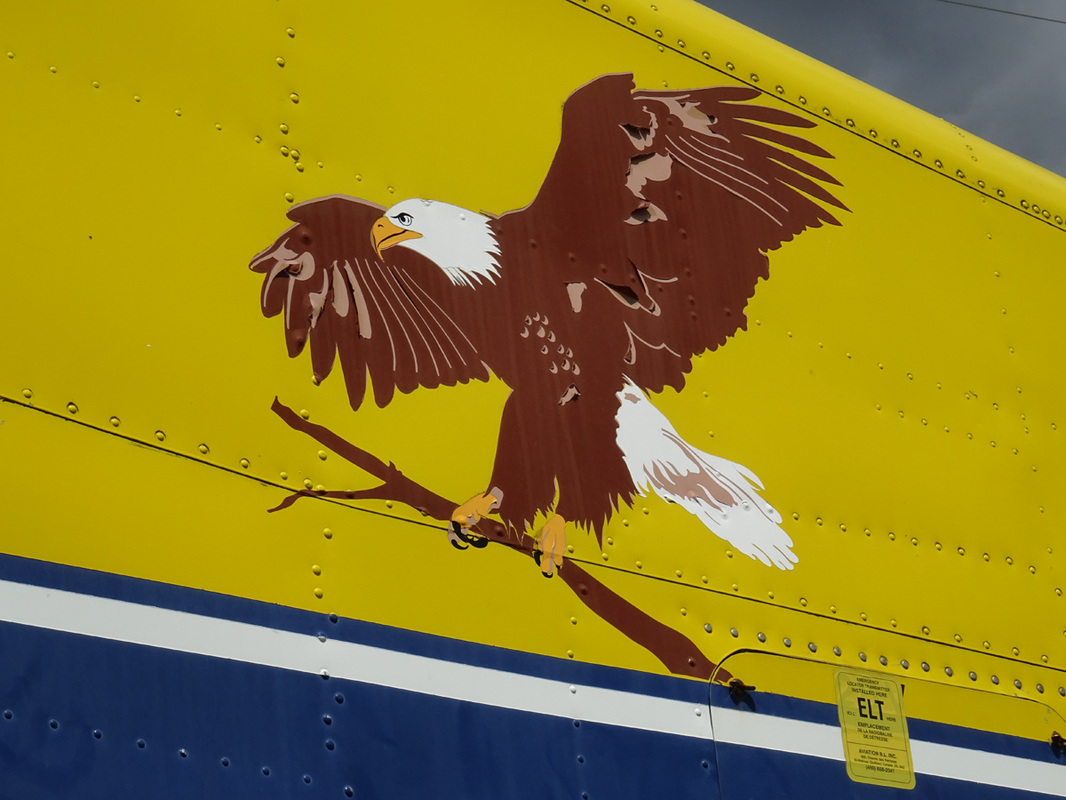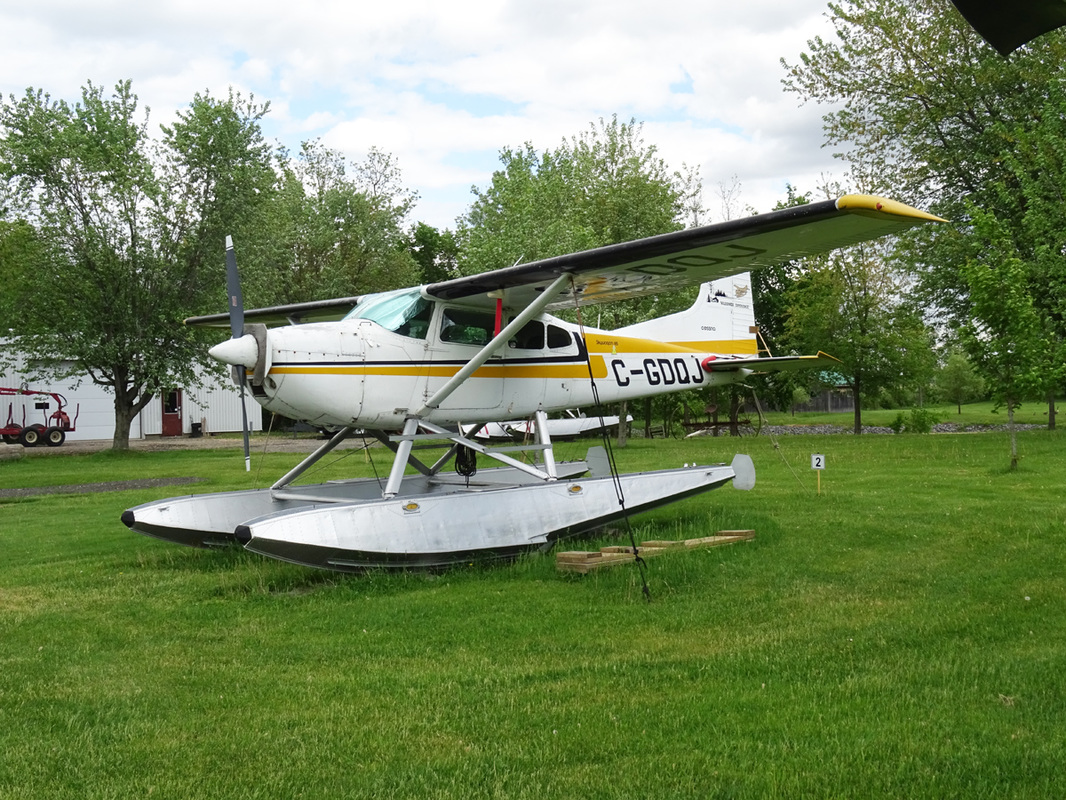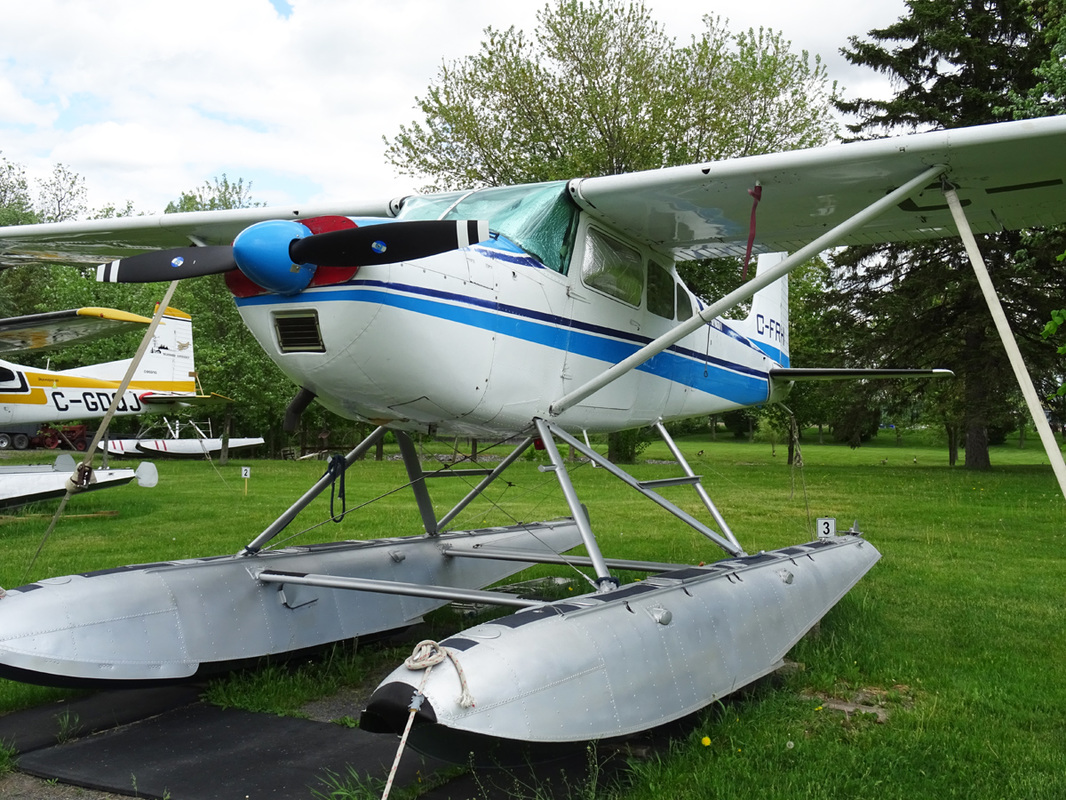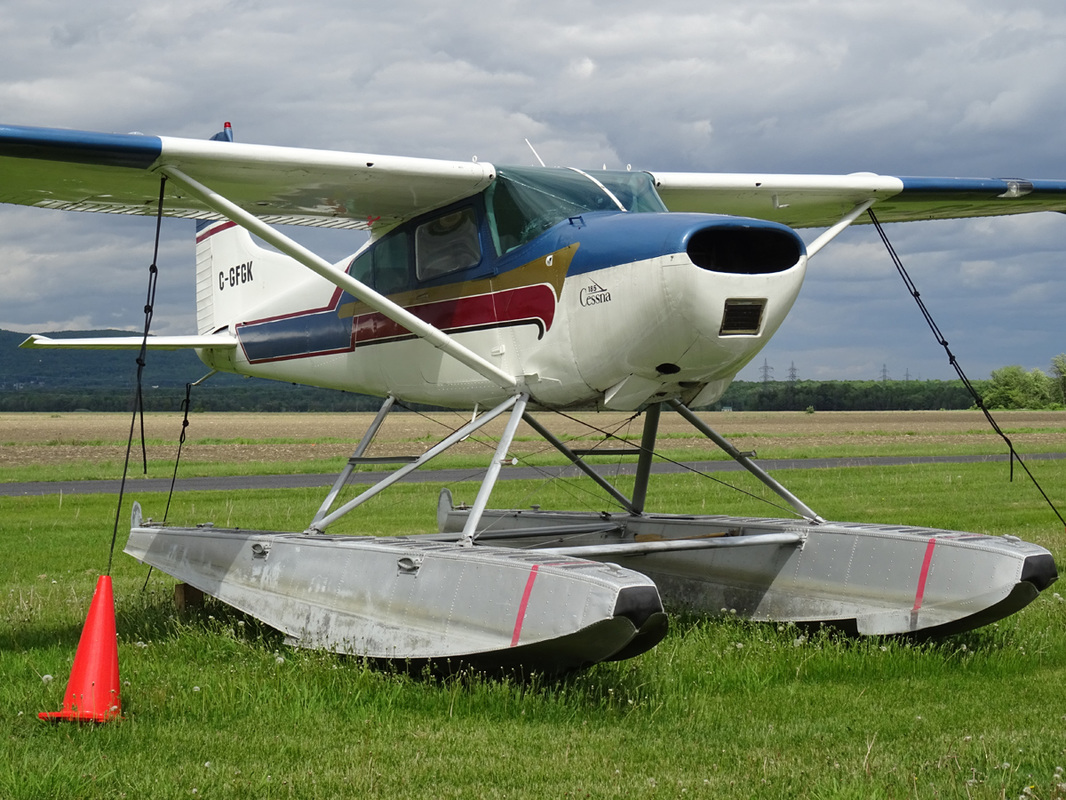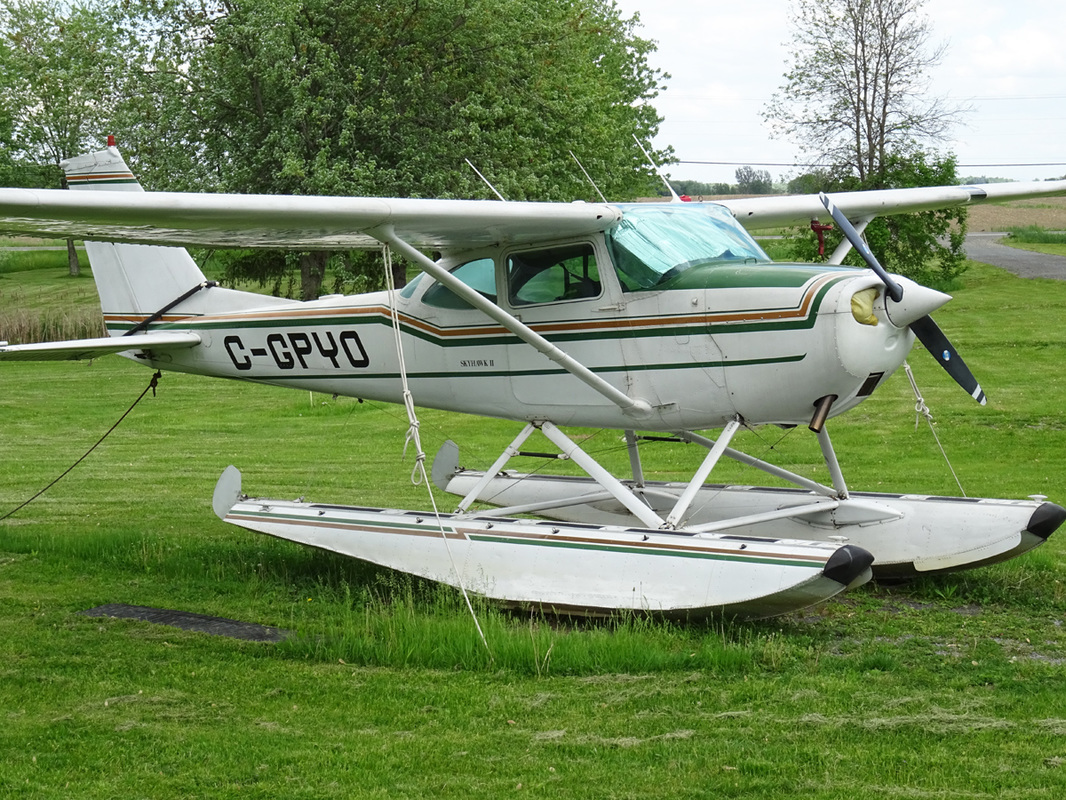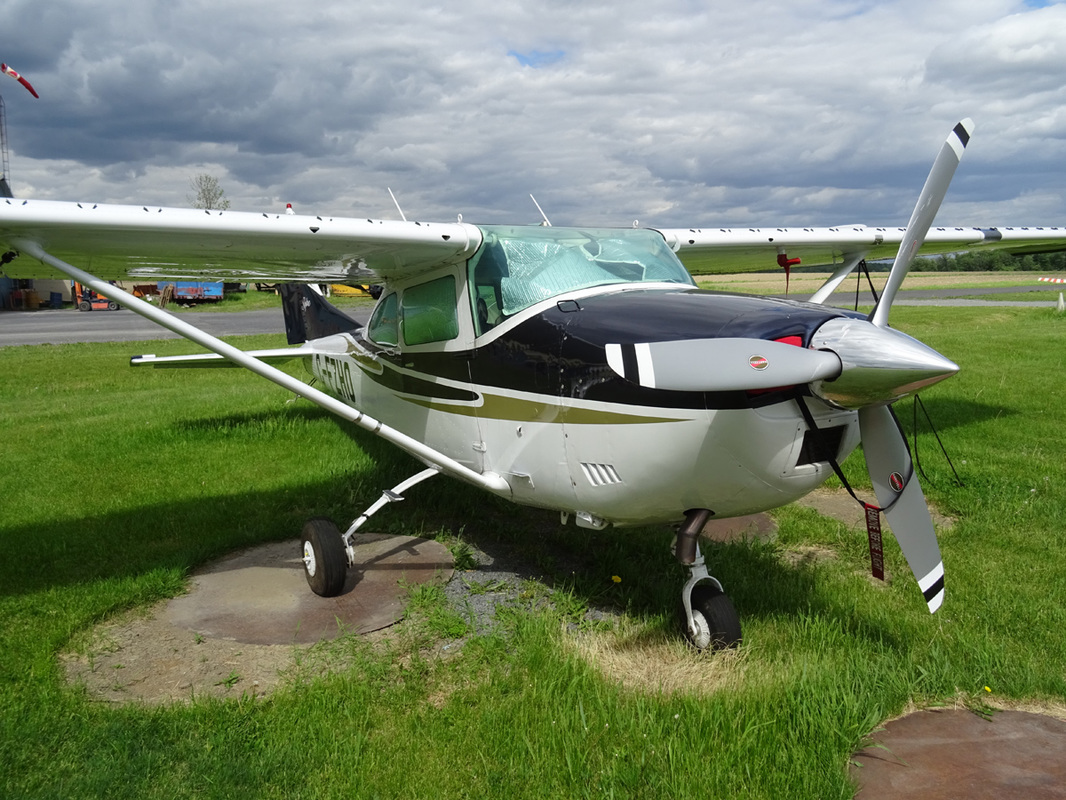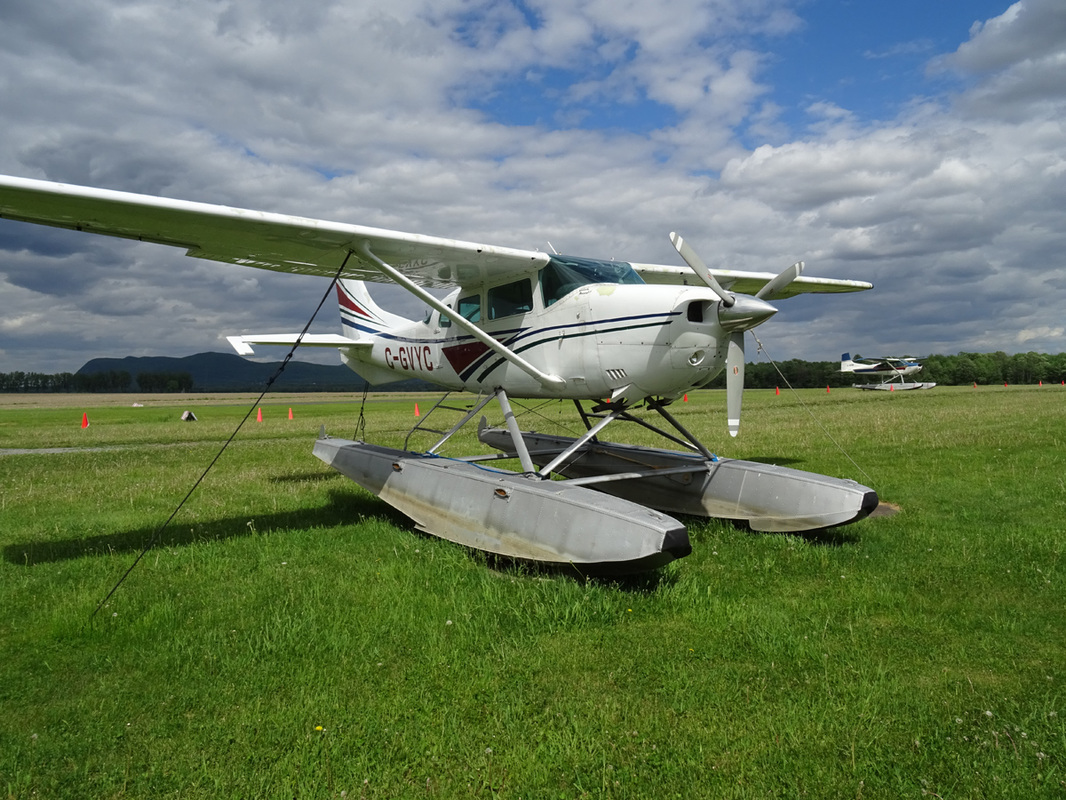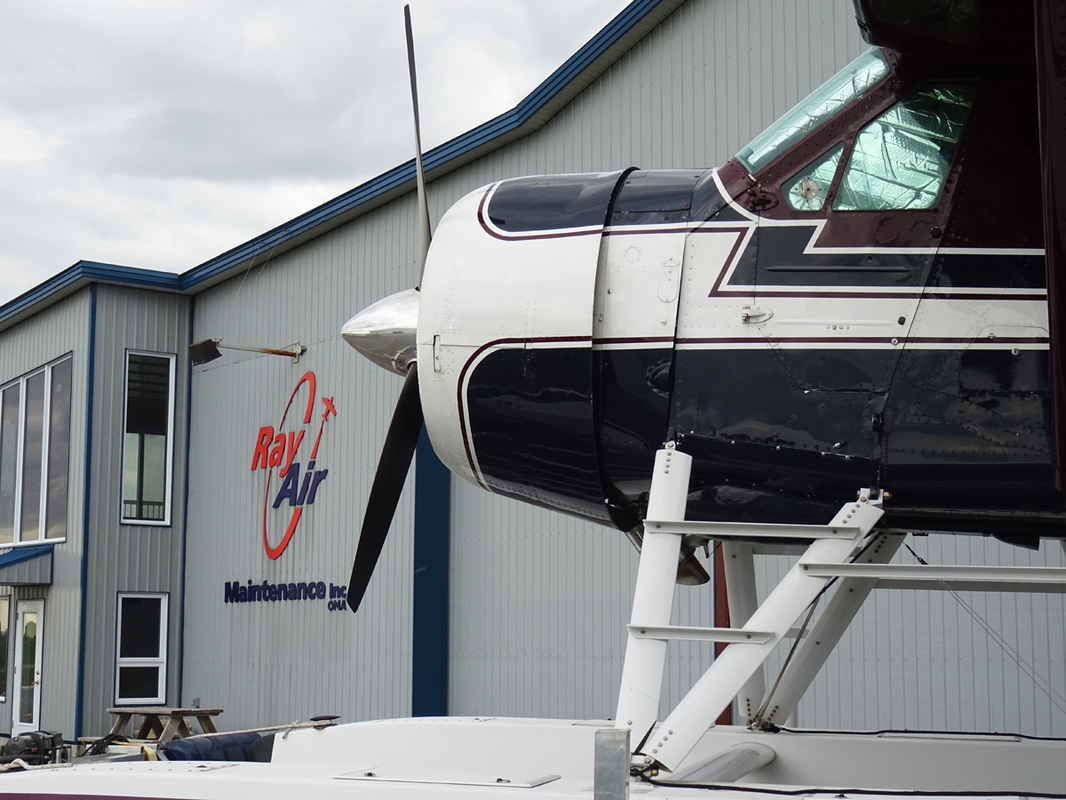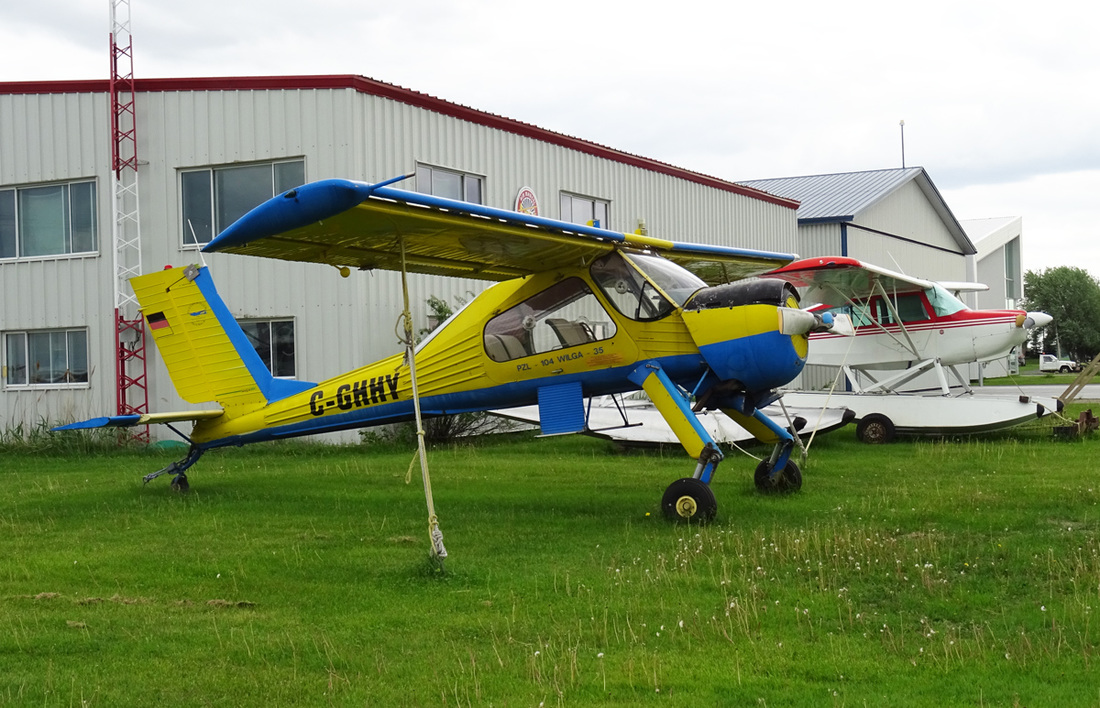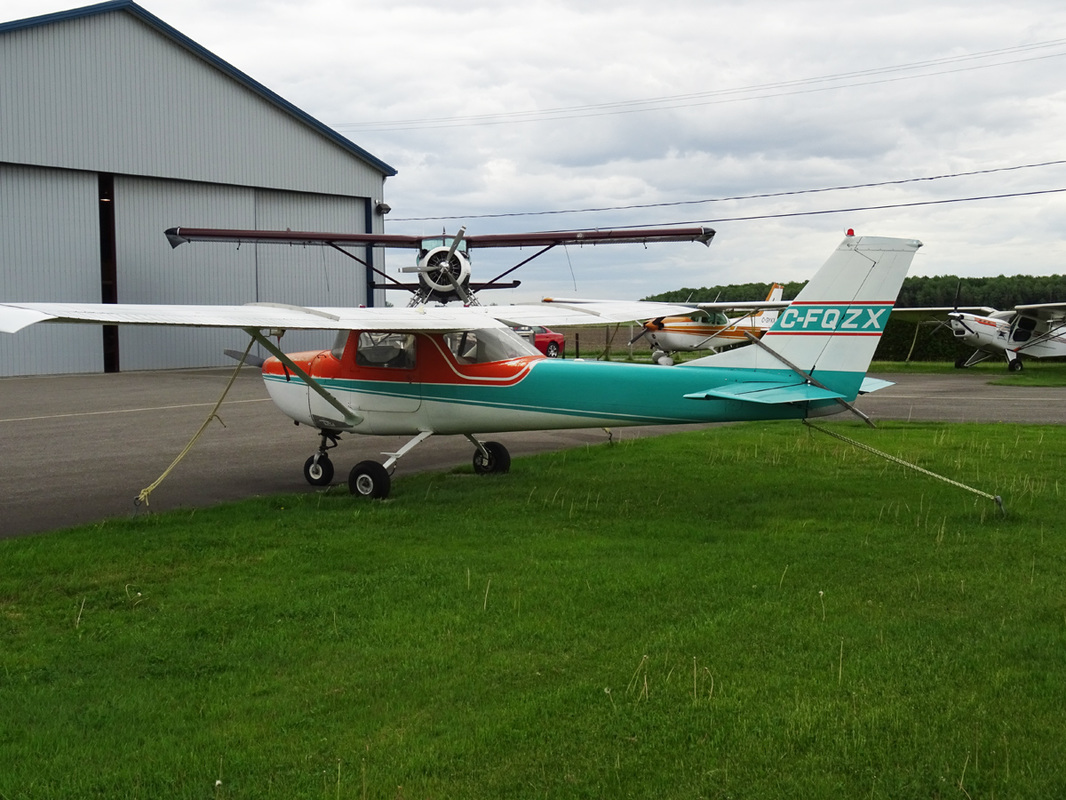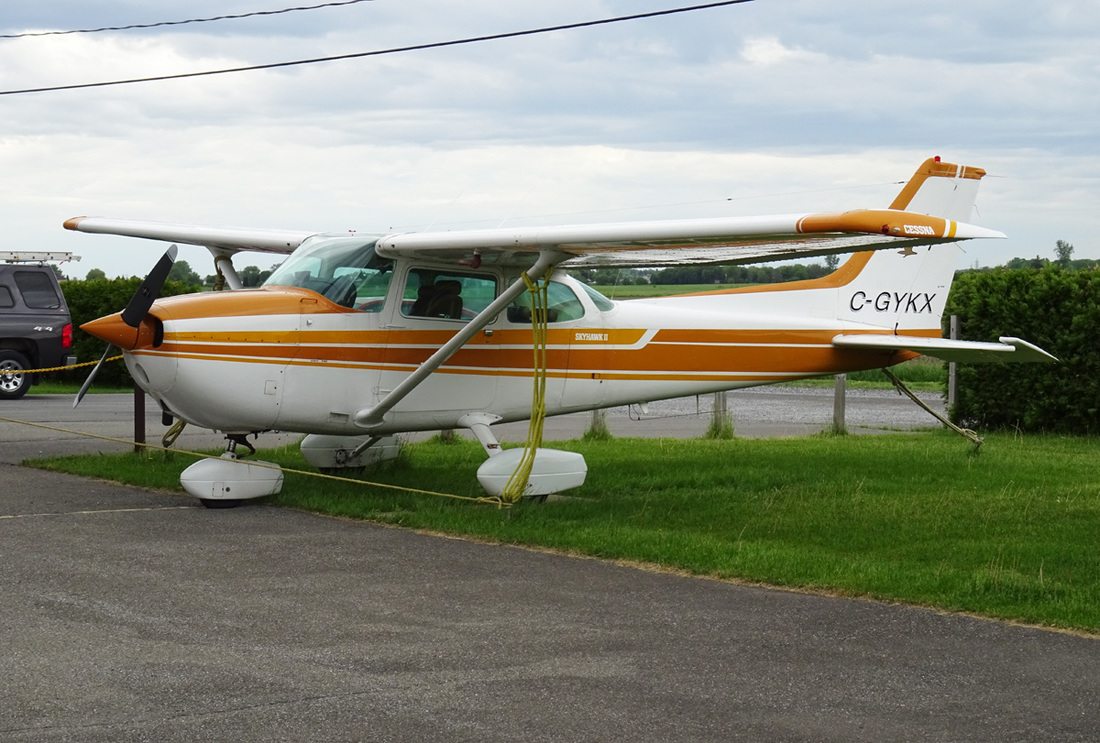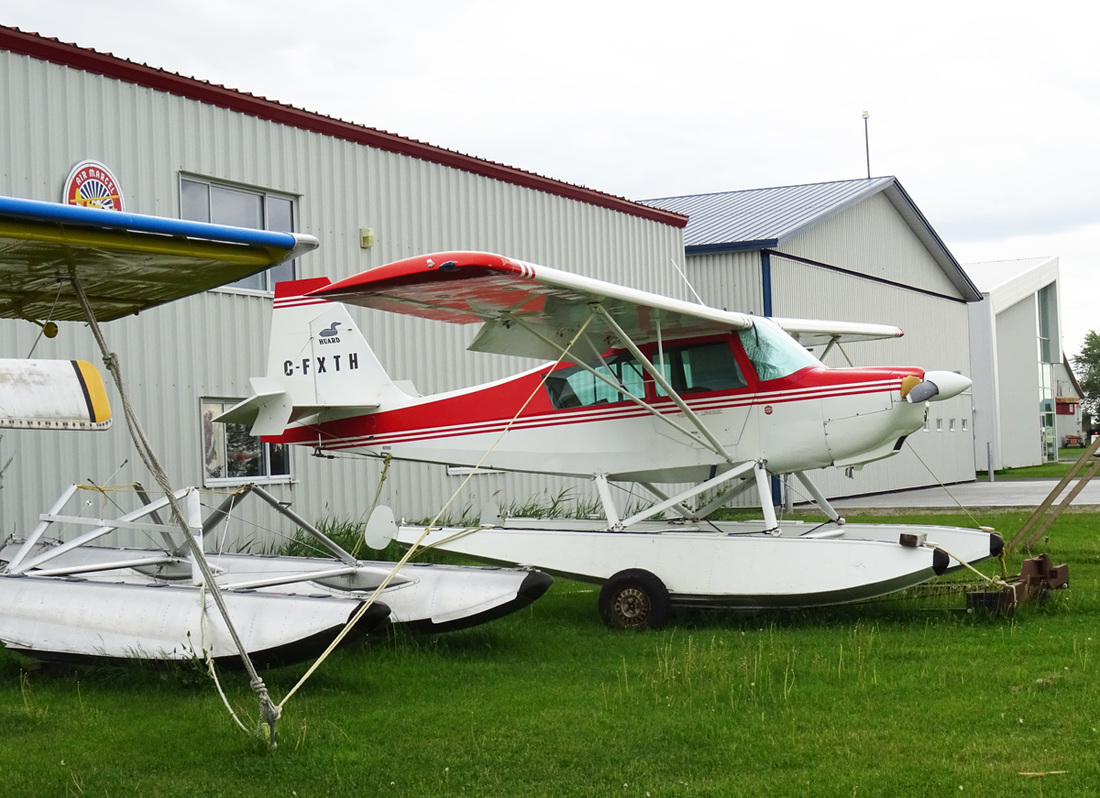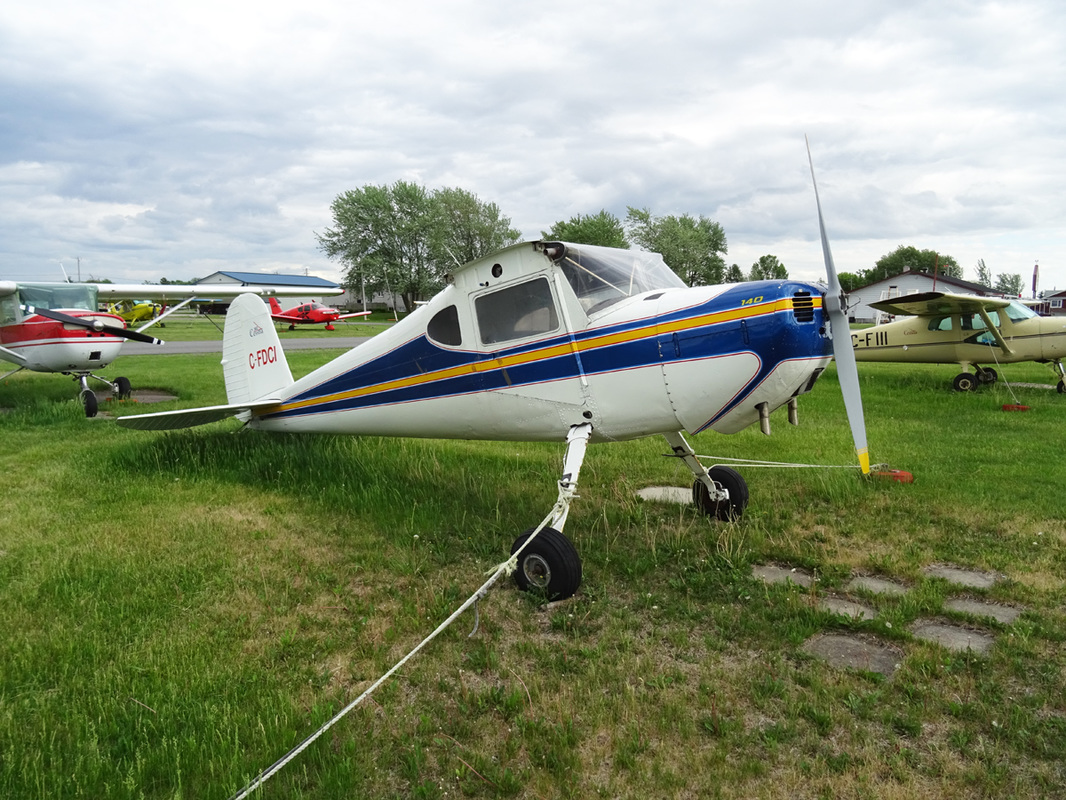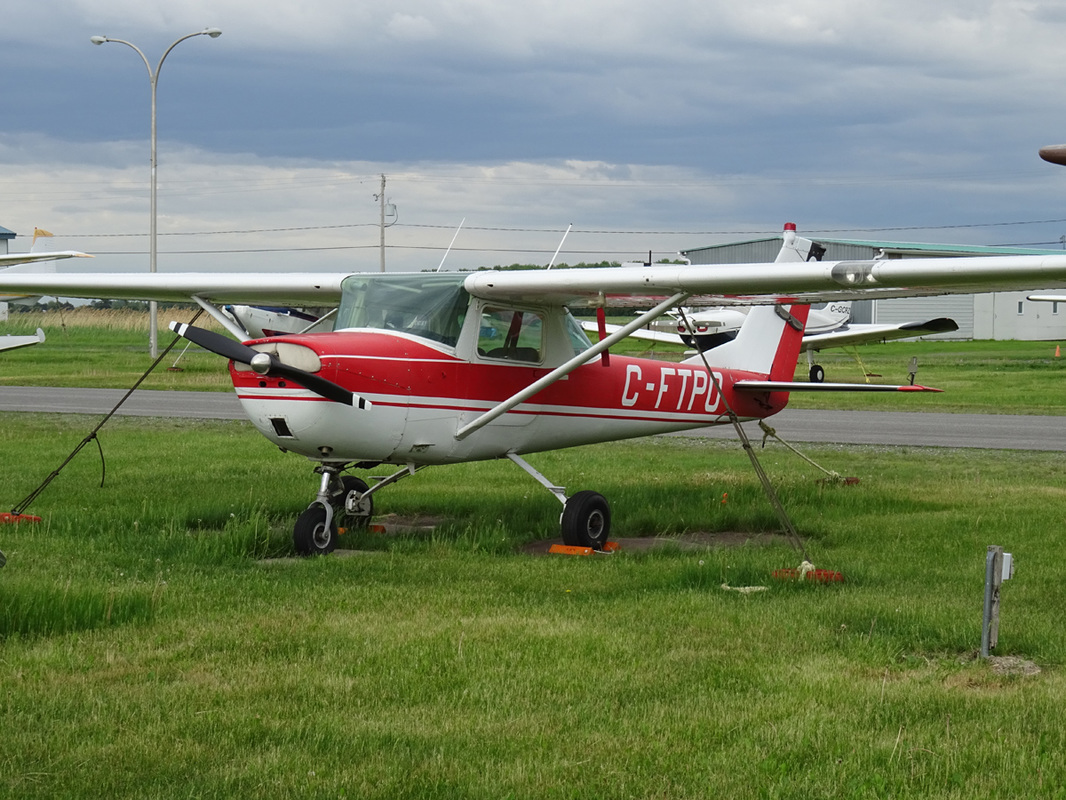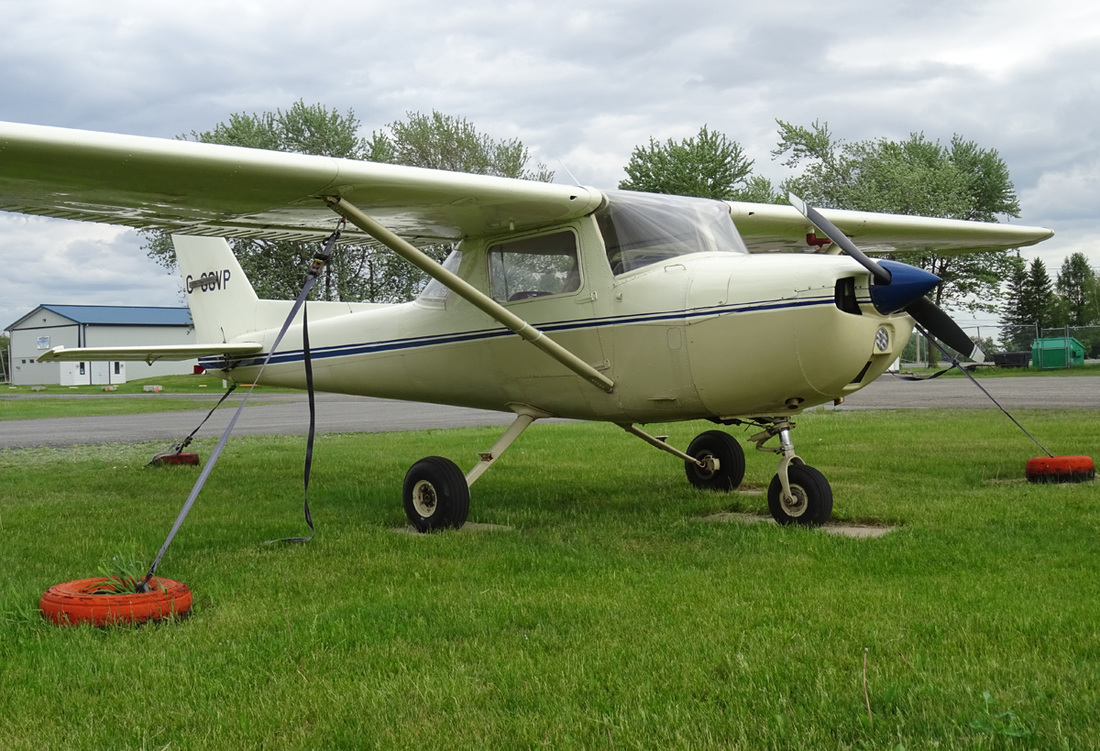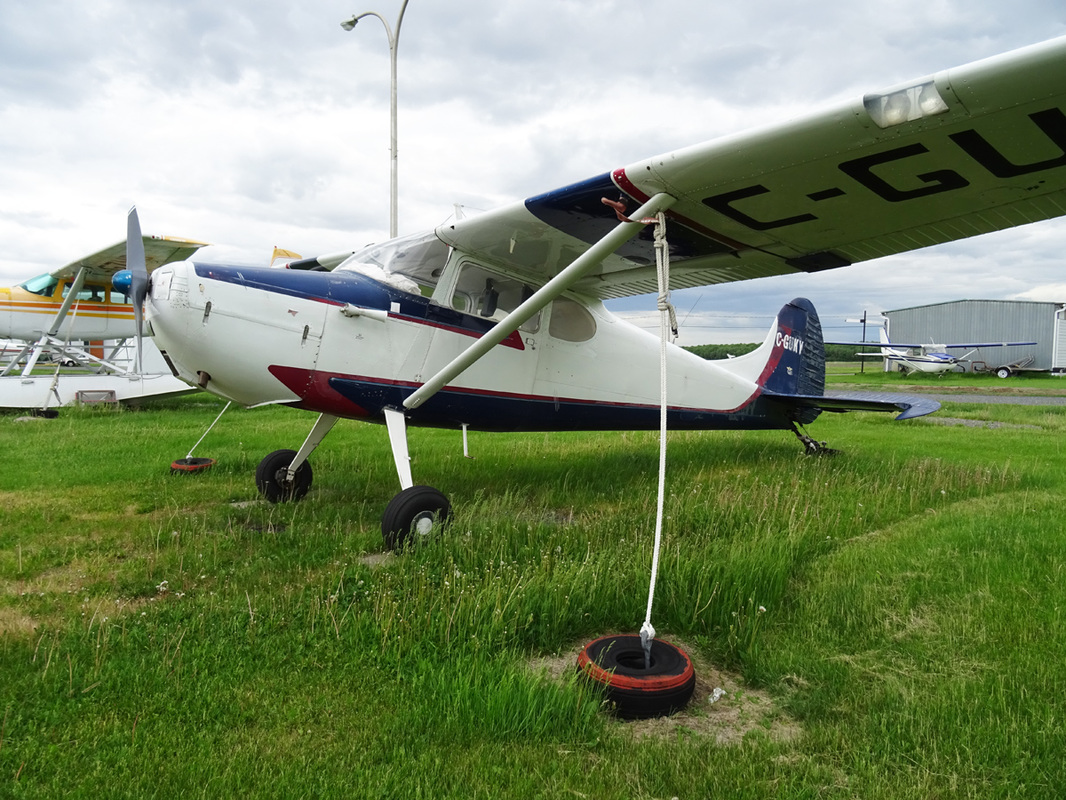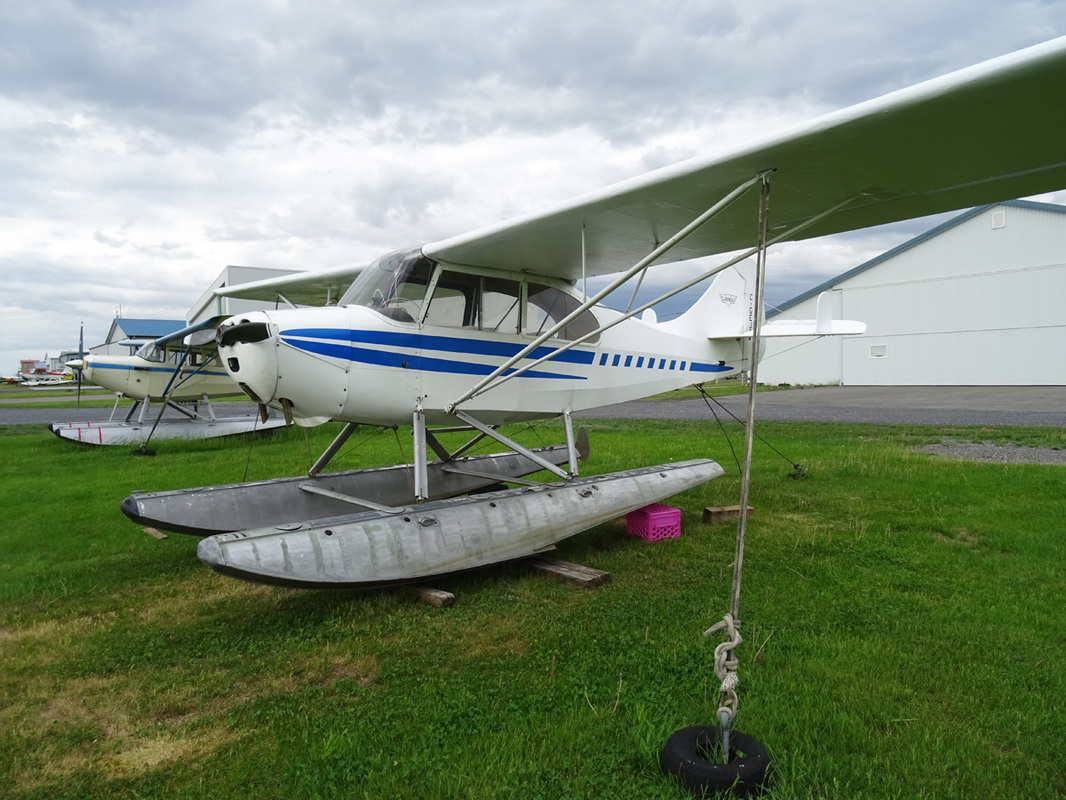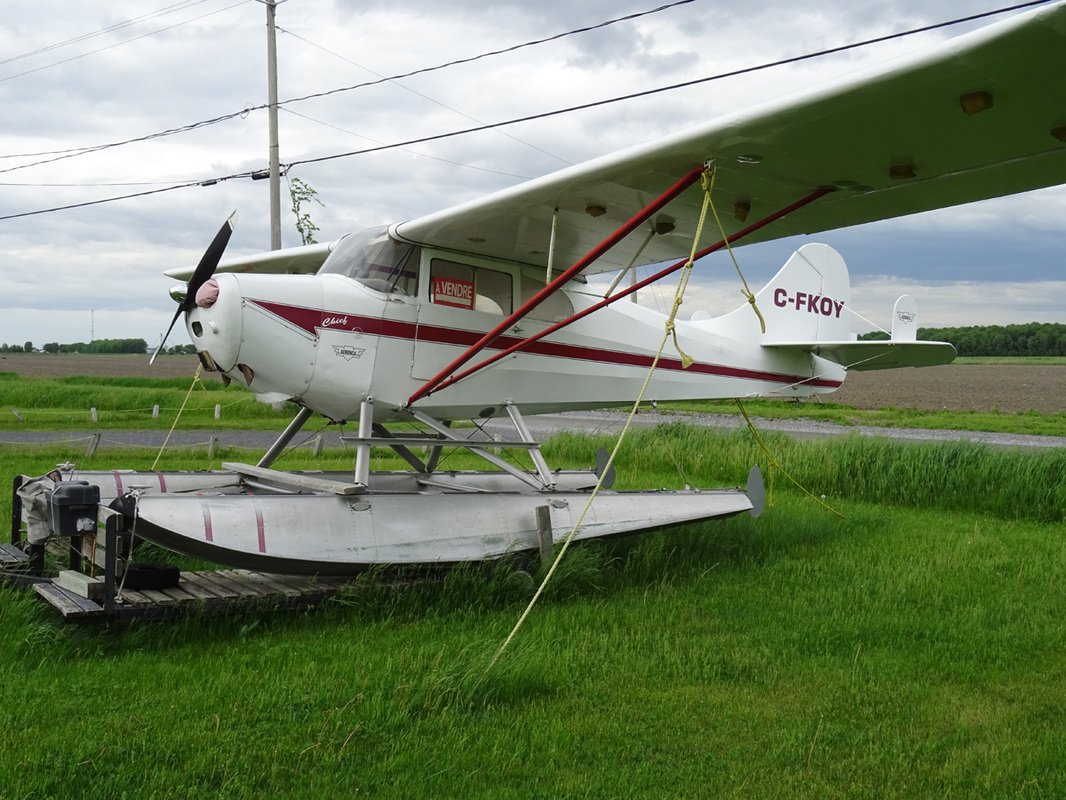Quebec Bush-planes 2016
The Three Saints
By Jan Koppen
Saint-Hubert
|
Montréal/Saint-Hubert Airport is located in the Saint-Hubert borough of Longueuil, Quebec. It is approx. 16 km (9.9 mi) east of Downtown Montreal.
In operation since 1928, it was Montreal's first and only airport until the construction of Montréal-Pierre Elliott Trudeau International Airport (formerly Montréal/Dorval International Airport). On 1 August 1930, the R100 airship arrived after what was possibly the first non-stop passenger-carrying powered flight across the North Atlantic to land in Canada. The airport was divided into two sides, a military side along with the Pratt & Whitney Canada facility (facing runway 06L/24R) and a civilian side (facing runway 06R/24L). The ex-Pratt & Whitney hangar is owned and operated since 2012 as the largest FBO on the airport. |
|
Canadian Vickers PBV-1A Canso C-FPQK was built in 1942
C-FPQK was constructed in 1943 as PBV-1A for the RCAF and registrated 9830. After her military duties were over during 1965 she was converted in the use by the department of Transport & Communications of Quebec.During 1979 she was transferred to the Government of Quebec, Quebec, who flew her as Tanker #712 before she was donated to the Foundation Aerovision Quebec, St. Hubert, Quebec in June 1994. Since this time she has been stored at St. Hubert Airport.
|
Canadian Vickers Limited was an aircraft and shipbuilding company that operated in Canada during the early part of the 20th century until 1944. A subsidiary of the UK parent, it built its own aircraft designs as well as others under licence. Canadair absorbed the Canadian Vickers Ltd. aircraft operations in November 1944.
In July 1941, the Canadian government awarded Canadian Vickers a contract to produce PBV-1 "Canso" amphibians (a version of the Consolidated PBY Catalina flying boat) for the Royal Canadian Air Force. Many of the aircraft were delivered to the United States Navy as the PBV-1; also to the United States Army Air Forces as the OA-10A for rescue work. To speed Canso production, the government authorized construction of a new manufacturing facility at Cartierville Airport in Ville Saint Laurent, on the north-western outskirts of Montreal, and appointed Canadian Vickers to manage the plant's operation on the government's behalf. Independently Boeing also produced Catalinas in Canada. In 1944, business pressure compelled Canadian Vickers to ask the government to relieve it of its management responsibilities regarding the Cartierville plant. Ottawa agreed and entered into a management contract with Canadair Limited, a new company founded by a small group of former senior Canadian Vickers personnel headed by Benjamin W. Franklin (no relation to his famous namesake). On 4 November 1944, Canadair Limited took over operation of the plant. In September 1946, Canadair Limited and the plant were acquired by the Electric Boat Company of Groton, Connecticut. In 1952, Electric Boat bought Consolidated Vultee and combined it, Canadair, and several smaller companies to form General Dynamics Corporation. General Dynamics later became one of the largest U.S. aerospace corporations. Canadair remained a General Dynamics subsidiary until January 1976 when it was re-acquired by the Canadian government. In December 1986, the government again sold Canadair, this time to Bombardier Inc., a Quebec-based international conglomerate. Today, Canadair itself no longer exists as a separate entity having been absorbed into Bombardier Aerospace. |
|
Built 1942. The Canso was a water-bomber and the predecessor of the Canadair CL-215/415.
|
Despite missing her powerful Pratt & Withney R-1830 Twin Wasp she still looks majestic!
C-FDTD saw service with Trans Canada Airlines between 1945 and 1963. Untill the end of the 80's she was owned and operated by the Canadian government. During 1992 she was donated to the Quebec Air and Space Museum to begin a musuem at St. Hubert. This apparently did not happend and the DC-3 has been parked eversince at St-Hubert airport. |
This, 1944 built, Douglas DC-3A-456 C-FDTD is owned by Foundation Aerovision Quebec.
|
The Dodge Charger is a brand of automobiles marketed by Dodge. The first Charger was a show car in 1964 followed by seven generations of Chargers. The official General Lee was one of the second generation. The Second generation rolled of the line during 1968–1970.
The 2nd generation Charger was redesigned for 1968, and sales increased. Based on the Chrysler B platform, the model years received various cosmetic changes to the exterior and interior including: an undivided grill, rounded tail lights, and hidden headlights. The powertrains were the same as the ones used in the 1967 Charger. Besides these modifications the model was not successful in stock car racing such as NASCAR. During this Quebec bush-plane hunting trip I was driving a 2015 Dodge Charger V-6 which is a Charger of the seventh generation. Read the following interesting drive review for more informeation about the nowadays Charger. The sensible V-6 sedan behind the Charger Hellcat's fury. In our ideal world, all Dodge Chargers would arrive packing V-8 power. In that alternate reality, where performing smoky burnouts is considered a patriotic duty and watching The Dukes of Hazzard reruns has displaced baseball as our national pastime, it would be an act of treason to deliver a Charger with fewer than eight cylinders. Reality, unfortunately, can be a real downer. Littered with buzz-killing responsibilities like turning a profit, meeting CAFE requirements, and amortizing development and production expenses, making it in the real world these days takes a well-rounded starting lineup. For the 2015 Dodge Charger, that means enough variants to hit all the price and performance points across the spreadsheet, from the top, er, uh, dog Hellcat Charger, which starts just shy of $65K, right down to the V-6–powered 2015 Dodge Charger SE and SXT models that start out with a base MSRP of $28,990. Four-Door Superhero When the 2015 Charger emerged from the design studio, only the roof and rear doors remained unchanged from the previous model. It’s clearly curvier with some softer edges. The designers tell us their inspiration for the grille came from the 1969 car and that its forward-leaning tilt is meant to give it the stance of a superhero. We’ll grant Dodge that one, but our take is that while the old grille was retro-modern Americana, the new one displays a more modern, worldly take on the crosshair design while maintaining a seriously sinister attitude. (SRT Chargers get their own fascia.) The side scallops, which took on an exaggerated appearance in the 2011-model-year makeover, have been refined, and the mounting point of the C-pillar has been moved even farther rearward to deliver a fastback appearance. There’s no way Dodge would leave its signature “racetrack” taillamp signature out of the equation; the entire ring glows softly whenever the headlights are on. Resisting the urge to plunge through the Charger’s windows Duke-boy style—our Charger drive took place in West Virginia, just a hog’s tail from the Dukes’ territory in Georgia—we went traditional and curled our paws underneath the husky door handles for access. Sliding behind the new three-spoke wheel reveals the same spacious interior dimensions that sizable drivers have come to know and love. For 2015, though, some refreshed surfaces, instrumentation, and minor control-input changes pay big dividends. A new, highly stylized yet restrained instrument-surround insert—Dodge calls it an “aluminum-lithograph driver bezel”—exudes an upscale look and feel, but it’s let down by the acres of textured plastic that cover the top of the dash. Although soft to the touch and light-years better than the plastics of just a few years ago, it still feels a bit industrial, like the material that might cover the gripping surfaces on a piece of exercise equipment. That said, a low-key matte finish mitigates the effect, while attractive stitched-fabric door upholstery and redesigned seating helps keep things looking and feeling luxe, something that can’t be said for the Abu Ghraib–grade benches of the previous car. Six Cylinders, Eight Speeds, Two- or Four-Wheel Drive Chrysler’s familiar 292-hp 3.6-liter Pentastar V-6 returns for duty in 2015, pumping the same 260 lb-ft of twist through the ZF-designed eight-speed automatic. The six is still happy drinking regular unleaded, saving a few pennies at the pump. Styling revisions aside, arguably the biggest change to hit the humble V-6 Charger models for 2015 is that they now use electric power steering. With three modes to choose from—Normal, Comfort, Sport—this helps the Charger perform its best trick, making 120.2 inches of wheelbase and two tons of curb weight feel considerably smaller than those figures imply. While the ratio remains the same at 14.4:1 and 2.6 turns lock-to-lock (16.5:1 and 3.1 for AWD models), switching to Comfort mode lightens the effort for parking-lot maneuvers, and Sport provides a nice—if somewhat artificial—weighty feel that complements the discernible on-center valley. Normal mode, as you might guess, splits the difference; we used it only long enough to find the setting button on the intuitive Uconnect system’s touch display. Combined with the stout and firmly damped chassis, the steering points the car just where you ordered, until you ask too much and the front tires begin to howl in a duet of understeer. We were also pleased to find that the electronic shifter, formerly an anti-intuitive device that often required a glance at the dash to determine which gear you had selected, has been modified with clear detents that telegraph changes in a more traditional fashion. The eight-speed automatic is standard for 2015, and the octo-box shifts quietly and capably, virtually disappearing in around-town driving. (There is no manual-transmission option in the cards for the 2015 Charger, regardless of trim level or engine.) Full-throttle inputs are met with a prompt response, the transmission holding gears until redline or the driver orders a change via the shift selector or the optional wheel-mounted paddles. It’s been a while since we last had some seat time in a Charger equipped with the Pentastar V-6 and eight-speed-automatic powertrain, but the almost stunningly low interior-noise levels in the 2015 model had us wondering whether Dodge had stuffed the body panels full of foam rubber. The Dodge folks tell us this isn’t so, that the NVH reduction largely results from continual refinement of the platform, which, we must point out, can trace its roots back more than a decade. The brakes use single-piston calipers front and rear, and although they never let us down or exhibited fade, we wish Dodge would get its low-MSRP gods to concede to making the more capable dual-piston front units from the V-8 cars standard across the range. As long as you’re not expecting V-8 levels of excitement, it’s hard to pick apart the entry-level Charger’s well-matched powertrain. Its EPA fuel-economy rating of 19 mpg city/31 highway only illustrates how far they’ve finessed it: In 2010, the base car was EPA-rated at 18/26 mpg, and its 2.7-liter V-6 made a meager 178 hp. Anyone paying off a five-year note and trading a 2010 Charger for this 2015 model is going to think the new one feels muscular even in base trim. A Charger is a big car, but like a heavyweight contender, it’s got some moves and is eminently comfortable in its skin. In the end, enthusiasts may find the most desirable quality of the V-6 Charger is that its bottom-line-boosting sales volume and contribution to Fiat-Chrysler’s CAFE standing makes possible the insanity of the Charger SRT Hellcat. To everyone else, it’s a fine large sedan for real-world money. |
'General Lee' in front of the majestic DC-3
|
Next halting place was Saint-Mathias waterdrome and airstrip along the Rivière Richelieu.
Saint-Mathias
|
Saint-Mathias Aerodrome, is located 1.7 nautical miles (3.1 km; 2.0 mi) northeast of Saint-Mathias-sur-Richelieu, Quebec, Canada.
|
BL-Aviation is doing full services for aircraft, seaplanes and power plants.
|
Back in 1972 Guy Bernier and Hubert Laurin decided to set up an aerial spraying business. Soon after, though, they found out that not only piloting the plane was important, but so was their upkeep. As time went by, their reputation as skilled mechanics grew in the aeronautical field. When the spraying season was over, they repaired aircrafts and seaplanes for private and commercial companies. This soon became the full-time endeavour of Aviation BL inc.
|
Shorts SC-7 Skyvan N194WW rolled-off the Belfast production-line in 1979 and was delivered new to the Saudi Min. of Petroleum as HZ-ZAS. In March 2014 she sold and registered to Win Win Aviation from Wake Forest, North Carolina, USA who leased this 'flying shoebox' to Nouvel Air Skydiving of Farham, Quebec.
BL-Aviation is doing full services for aircraft, seaplanes and power plants.
C-FRSL, is a Cessna A185E Skywagon. Based upon the 180 airframe, the Skywagon 185 is famous for its size, speed, and ease of flying. For the first five years, it was powered by the 260-hp Continental. That engine was replaced the following year by the 520-cu. in., six-cylinder powerplant rated at 300 hp for takeoff at 2,850 RPM. The 185 will take off in 1,025 feet, climb out at better than 1,000 fpm, and 01-Single-cruise at 167 mph while carrying a 1,663-pound useful load. Fuel injection enhances its all-weather reliability and economical operation. Its high-lift wing with modified Frise all-metal ailerons and 28.8 sq. ft. of Para-Lift flaps afford easy handling over obstacles. A full sixplace aircraft, its seats are easily removable to provide fast change to all-cargo configuration. Its rugged interior and reinforced floor allow it to handle heavy loads, and its double cargo doors facilitate loading. Like the 180, the 185 is easily transformed into a skiplane, floatplane, or amphibian. In 1979, optional wheel fairings were offered to increase speeds by one knot, and a McCauley three-blade propeller could be ordered for smoother, quieter flight and more ground clearance. In addition to the same spray system option offered for the 180, the 185 received a three-blade propeller for lower vibration and a quieter cabin in 1980. Also, the 20-degree flap speed was increased from 90 mph to 110 mph.
BL-Aviation Prop-Shop at Saint-Mathias
Mr. Jean-Guy Bernier specializes in propellers manufactured by McCauley, Hartzell and Sensenich, while Mr. Patrice Dumont is specialized on Hamilton Standard propellers. BL Aviation propellers revision department was created in 1989 and it is unique in Quebec with clients coming from all across Canada and the Northeast of the United States.
CF-ZNH was constructed in 1952 as Beechcraft D-18S for the RCAF. After her military duties were over the Beech was transferred to Canadian Forces Aircraft Technicians School at Border during 1968. She went into storage awaiting sale at Saskatoon, Saskatchewan during January 1970. Three months later she was sold to G. Provencher of Montreal and registrated as CF-ZNH. Later owners included R. Shaw of Ottawa, Ottawa Sports Parachutists and M.R. Aviation of Laval. Her last owner was Parachutisme Nouvel Air Inc. of Farnham.
|
A former Confiair Aviation Inc. truck is to be found dormant at St. Mathias airport.
Conifair Aviation was formed in 1978 at St Jean, Quebec, by two French-Canadian businessmen in order to operate former Christler Flying Service 749 Constellation sprayer aircraft on lucrative spraying contracts in Canada on behalf of the Ministere des Terres et Forets (Department of Lands and Forests). Three 749s, which had already been operated successfully as sprayers for nearly a decade, were delivered to Canada and immediately prepared for the 1979 budworm spraying season. The villainous budworm spread through forests, eating the buds from trees, and unless action is taken, they will destroy millions of dollars worth of valuable forest. Unforetunately Conifair went out of business in 1985. |
|
The Beech 18 is a classic in the aviation world as well as at Nouvel Air Skydiving. It is a twin-engine aircraft with a capacity of 13 passengers and is tried, tested and true when it comes to skydiving. It is actually this type of aircraft that our company chose when it established the dropzone in the 90s.
Skydivers are unanimous on one point: jumping out of the Beech is a unique experience that you have to try at least once in your life! |
C-GGWR, seen here at Saint-Mathias (40km east of Montreal), is a 1967 built Lake LA-4-180 Amphibian.
Lake Aircraft was a manufacturer of amphibious aircraft. Its factory was in Sanford, Maine, USA.
The first design in the series produced was the Colonial Skimmer. It was derived from an original design produced by David Thurston in 1946 when he was with Grumman Aircraft. Grumman never produced the design, but Thurston formed Colonial Aircraft Corporation as a side business to continue development.
Colonial's first amphibious aircraft, designated the "Colonial Aircraft C-1 Skimmer" and based on the original Grumman G-65 Tadpole design, first flew in 1948. Colonial grew to produce almost 50 of the C-1 and larger C-2 design before being sold in 1959.
The new owner, M.L. (Al) Alson, renamed the company Lake Aircraft and enlarged the basic design again into the LA-4, a 180-horsepower, 4-seat aircraft, which was the basis for the entire line of aircraft that continues today. For many years the Lake LA-4-200 was advertised as "The world's only single-engine production amphibian."
Lake Aircraft was a manufacturer of amphibious aircraft. Its factory was in Sanford, Maine, USA.
The first design in the series produced was the Colonial Skimmer. It was derived from an original design produced by David Thurston in 1946 when he was with Grumman Aircraft. Grumman never produced the design, but Thurston formed Colonial Aircraft Corporation as a side business to continue development.
Colonial's first amphibious aircraft, designated the "Colonial Aircraft C-1 Skimmer" and based on the original Grumman G-65 Tadpole design, first flew in 1948. Colonial grew to produce almost 50 of the C-1 and larger C-2 design before being sold in 1959.
The new owner, M.L. (Al) Alson, renamed the company Lake Aircraft and enlarged the basic design again into the LA-4, a 180-horsepower, 4-seat aircraft, which was the basis for the entire line of aircraft that continues today. For many years the Lake LA-4-200 was advertised as "The world's only single-engine production amphibian."
|
C-FQYF is a 1956 built Piper Aircraft PA-18-150 Super Cub. The PA-18-150 Super Cub is the 1954 variant with a 150 hp Lycoming O-320.
The Piper PA-18 Super Cub is a two-seat, single-engine monoplane. Introduced in 1949 by Piper Aircraft, it was developed from the Piper PA-11, and traces its lineage back through the J-3 to the Taylor E-2 Cub of the 1930s. In close to 40 years of production, over 9,000 were built. Super Cubs are commonly found in roles such as bush flying, banner and glider towing. While based on the design of the earlier Cubs, the addition of an electrical system, flaps (3 notches), and a considerably more powerful engine (150 hp), make it a very different flying experience. Although the "standard" Super Cub was fitted with a 150-horsepower (112 kW) Lycoming engine, it is not uncommon to see them equipped with a 160-horsepower O-320-B2B, or even 180 horsepower (134 kW) Lycoming O-360 powerplant. The high-lift wing and powerful engine made the Super Cub a prime candidate for conversion to either floatplane or skiplane. In addition, the PA-18A (an agricultural version) was produced for applying either dry chemical or liquid spray. |
C-GARZ is a 1975 built Piper Aircraft PA-18-150 Super Cub. The PA-18-150 Super Cub is the 1954 variant with a 150 hp Lycoming O-320.
The first true "Super" Cubs had flaps, dual fuel tanks, and an O-235 Lycoming engine producing about 108 hp (115 hp for takeoff only). However, a 90 hp Continental variant without flaps and an optional second wing tank was available. Their empty weight was, on the average, 800–1000 pounds with a gross weight of 1,500 lb. These Cubs would take off in about 400 feet (at gross weight) and land in about 300 feet (thanks to the flaps). The Super Cub is renowned for its ability to take off and land in very short distances.
The first true "Super" Cubs had flaps, dual fuel tanks, and an O-235 Lycoming engine producing about 108 hp (115 hp for takeoff only). However, a 90 hp Continental variant without flaps and an optional second wing tank was available. Their empty weight was, on the average, 800–1000 pounds with a gross weight of 1,500 lb. These Cubs would take off in about 400 feet (at gross weight) and land in about 300 feet (thanks to the flaps). The Super Cub is renowned for its ability to take off and land in very short distances.
|
C-FPLA is a 1960 built Piper Aircraft PA-18S. The S is the designation for production aircraft fitted with floats.
The first Super Cubs were going to be offered with a unique four-wheel tandem main landing gear designed for landing and takeoff from rough terrain, but eventually a simpler and lighter two-wheel unit replaced the four-wheel design. The O-290 Lycoming powered Cubs (135 hp) followed and would take off in about 200 feet (61 m). The landing distance remained the same at about 400 feet (120 m), or 300 feet (91 m) using flaps. With the use of the Lycoming O-320 at 150–160 hp, the Cub's allowable gross weight increased to 1,750 lb while retaining the capability of a mere 200 feet (61 m) required for takeoff. |
C-FSRP is a 1962 built Piper Aircraft PA-18.
The PA-18 has developed a very dedicated following in the bush-flying community, and many modifications have been developed for it, to the point where it is quite rare to find an original, completely stock Super Cub. Modifications include extended baggage compartments (reaching farther back into the fuselage, or even two-level baggage compartments in the top and bottom of the rear fuselage), external luggage pods, fuel pods, lumber racks for carrying construction materials into unimproved bush runways. Also the removal of header tanks, larger 24 or even 30 gallon wing fuel tanks, extended main landing gear for better ground clearance of the propeller, strengthened tailwheel springs, the addition of a small third passenger seat in the luggage area and lightweight generators and starters. Also various different mount areas for the battery (to move the weight forward, and reduce tail weight to shorten takeoff distance), various different tailfin shapes to increase surface area, lengthened flaps, various wingtip designs, vortex generators on the leading edge of the wings, movement of the electrical panel from the right wing root to the dashboard to reduce fire hazard during a crash, and even the addition of a constant-speed propeller. Above all, the most common modification is the addition of "bush wheels", large, soft, low pressure balloon-tires designed to absorb impacts from rocks and boulders, and to not sink into sand or other soft surfaces, ideal for off-runway landings.
|
C-FNNF is a 1954 built Piper Aircraft PA-18-150 Super Cub. The PA-18-150 Super Cub is the 1954 variant with a 150 hp Lycoming O-320.
The Super Cub retained the basic "rag and tube" (fabric stretched over a steel tube frame) structure of the earlier J-3 Cub. The Cub is a high-wing strut-braced monoplane with a large area rectangular wing. It is powered by an air-cooled piston engine driving a fixed pitch propeller. Its fuselage is a welded steel frame covered in fabric, seating two people in tandem. The aircraft's standard chrome yellow paint has come to be known as "Cub Yellow". |
C-FJAE, seen here at Saint-Mathias (40km east of Montreal), is a 1946 built Stinson 108 Voyager.
The Stinson 108 was a popular general aviation aircraft produced by the Stinson division of the American airplane company Consolidated Vultee, from immediately after World War II to 1950. It was developed from the prewar Model 10A Voyager. Stinson was bought by Piper Aircraft in 1949. All Stinson model 108, 108-1, 108-2, 108-3 and 108-4 aircraft were built by Stinson at Wayne, Michigan. When Stinson sold the type certificate to Piper in 1949, approximately 325 airplanes of the 5,260 model 108s built by Stinson were complete but unsold. These 325 model 108s went to Piper as part of the sale. Piper then sold that inventory as the Piper-Stinson over the next few years.
The fuselage was of fabric-covered steel tube. Aftermarket modifiers have obtained supplemental type certificates (STC) allowing conversion to an aluminum covering. Many different engines have been installed in the 108 by STC such as the Lycoming O-360, Franklin 220|220, Continental O-470. One distinctive feature was the partial leading edge slot installed on the wings and aligned with the ailerons on the trailing edge, ensuring that the portion of the wing containing the aileron remains unstalled at higher angles of attack, thus contributing to docile stall behavior.
Total new production of the Stinson Model 108, by Stinson, was 5,260. Stinson delivered approximately 4,935 aircraft and Piper delivered approximately 325 aircraft. Piper later sold the type certificate to Univair Aircraft Corporation.
The fuselage was of fabric-covered steel tube. Aftermarket modifiers have obtained supplemental type certificates (STC) allowing conversion to an aluminum covering. Many different engines have been installed in the 108 by STC such as the Lycoming O-360, Franklin 220|220, Continental O-470. One distinctive feature was the partial leading edge slot installed on the wings and aligned with the ailerons on the trailing edge, ensuring that the portion of the wing containing the aileron remains unstalled at higher angles of attack, thus contributing to docile stall behavior.
Total new production of the Stinson Model 108, by Stinson, was 5,260. Stinson delivered approximately 4,935 aircraft and Piper delivered approximately 325 aircraft. Piper later sold the type certificate to Univair Aircraft Corporation.
C-GKGX, seen here at Saint-Mathias (40km east of Montreal), is a Wag-Aero Wag-a-Bond.
The Wag-Aero Wag-a-Bond was designed by Dick Wagner as a Piper PA-17 Vagabond replica and first flew on 9 June 1978. The Wag-Aero Group is an American aircraft manufacturer, that was founded by Dick and Bobbie Wagner in the 1960s and is based in Lyons, Wisconsin. The company was specialized in the design and manufacture of kit aircraft and aircraft parts for amateur construction.
Wag-Aero was started by Dick and Bobbie Wagner in the 1960s and run from the basement of their home in Lyons, Wisconsin. In 1971 the company moved into permanent quarters and an aerodrome was constructed to accommodate fly-in customers, now known as Wag-Aero Airport.
In addition to aircraft parts, the company supplied parts and kits to construct several light aircraft designs, all based on 1930s and 1940s Piper Aircraft models. On 1 September 1995 the Wagners sold the group of companies.
Wag-Aero was started by Dick and Bobbie Wagner in the 1960s and run from the basement of their home in Lyons, Wisconsin. In 1971 the company moved into permanent quarters and an aerodrome was constructed to accommodate fly-in customers, now known as Wag-Aero Airport.
In addition to aircraft parts, the company supplied parts and kits to construct several light aircraft designs, all based on 1930s and 1940s Piper Aircraft models. On 1 September 1995 the Wagners sold the group of companies.
C-FEQA, seen here at Saint-Mathias (40km east of Montreal), is a 2009 Aeronca amateur-built Super L3B and owned by Yvon Guertin.
C-FALD, is a 2005 built Gbair GBAIT-7-T Turbo Prop with construction number 001.
C-FSRG, is a 2007 built Cruiser Special with construction number 001.
C-FJRK, seen here at Saint-Mathias (40km east of Montreal), is a 2004 built Maule M-5-235C Lunar Rocket.
The Maule M-5 is an American four-seat cabin monoplane designed and built by the Maule Aircraft Company. The M-5 was a development of the earlier Maule M-4 with improved STOL performance. It has a 30% increase in flap area and enlarged tail surfaces.
Two prototype M-5s flew in 1971. The M-5 is a steel-tube and fabric high-wing braced-monoplane with a cantilever tailplane with a single fin and rudder. It has a fixed-tailwheel landing gear and an enclosed cabin with two rows of side-by-side seating for a pilot and three passengers. The aircraft entered production in 1974 and was named the Strata Rocket and the Lunar Rocket. A generally similar M-6 Super Rocket was also developed with a 3-foot-longer (0.91 m) wingspan and more fuel capacity, smaller ailerons and larger flaps.
The M-5-235C Lunar Rocket variant is a basicly a M-5-210C Strata Rocket fitted with a 235-horsepower (175 kW) Lycoming O-540-J1A5D engine. More than 379 built of this variant were built.
Two prototype M-5s flew in 1971. The M-5 is a steel-tube and fabric high-wing braced-monoplane with a cantilever tailplane with a single fin and rudder. It has a fixed-tailwheel landing gear and an enclosed cabin with two rows of side-by-side seating for a pilot and three passengers. The aircraft entered production in 1974 and was named the Strata Rocket and the Lunar Rocket. A generally similar M-6 Super Rocket was also developed with a 3-foot-longer (0.91 m) wingspan and more fuel capacity, smaller ailerons and larger flaps.
The M-5-235C Lunar Rocket variant is a basicly a M-5-210C Strata Rocket fitted with a 235-horsepower (175 kW) Lycoming O-540-J1A5D engine. More than 379 built of this variant were built.
|
C-FMLE, is a Maule MX-7-180B. The Maule M-7 is a family of single-engine light aircraft that has been manufactured in the United States since the mid-1980s.
Based on the Maule M-4, it is a high-wing, strut-braced monoplane of conventional configuration, available with tailwheel or optional and frequently used as a seaplane with twin pontoons. The basic M-7 has a longer cabin than its predecessors the M5 & M6, with two seats in front, a bench seat for up to three passengers behind them, and an optional third row of "kiddie seats" at the rear. |
C-FYRA, seen here at Saint-Mathias (40km east of Montreal), is a Javelin V6 STOL.
It is an American STOL homebuilt aircraft that was designed and produced by Javelin Aircraft of Wichita, Kansas. The V6 STOL consists of an existing certified airframe with a Ford Motor Company V6 engine and moving it from the Certified Category to the Experimental Amateur-built category.
C-GAGH, seen here at Saint-Mathias, is the second prototype of the Dream Tundra 200.
The Dream Tundra is a robust, single-engine, high-wing monoplane designed in Canada. Seating four, its short takeoff and landing characteristics can be adapted to land, snow, or water use. It is produced as a kit for homebuilding.
The Tundra, Dream Aircraft's first and only product to date, is a kit-built aircraft designed for robustness and STOL performance, seating four in two side-by-side rows. It is almost entirely of riveted aluminium construction, though flying surface tips are composite, and is laid out in conventional high-wing, single-engine, form. The first Tundra flew on 12 May 2001. The kit manufacturer estimates the construction time at 1000 hours. Tundra 200 is a later version with sprung steel main landing gear and powered by a 150 kW (200 hp) Textron Lycoming IO-360 engine.
The Tundra, Dream Aircraft's first and only product to date, is a kit-built aircraft designed for robustness and STOL performance, seating four in two side-by-side rows. It is almost entirely of riveted aluminium construction, though flying surface tips are composite, and is laid out in conventional high-wing, single-engine, form. The first Tundra flew on 12 May 2001. The kit manufacturer estimates the construction time at 1000 hours. Tundra 200 is a later version with sprung steel main landing gear and powered by a 150 kW (200 hp) Textron Lycoming IO-360 engine.
|
C-FKLX, seen here at Saint-Mathias (40km east of Montreal), is Zenair STOL CH-701 on Full Lotus Floats.
The Zenith STOL CH 701 is family of a kit-built STOL aircraft designed by Canadian aeronautical engineer Chris Heintz through his Midland, Ontario based company, Zenair. The CH 701 first flew in 1986 and the design was still in production in 2011. The CH 701 was later developed into the four-place Zenith STOL CH 801. Designed for off-runway operations, the all-metal CH 701 has many features that contribute to the aircraft's capabilities, such as a high-lift wing with full-span, non-movable leading edge slots, an all-flying rudder, large tires, flaperons and an inverted elevator. Heintz also designed a unique tricycle gear amphibious float system for the CH 701. The STOL CH 701 variant is the base model, introduced in 1986, with a gross weight of 1100 lbs (500 kg). The engine used on C-FKLX Rotax 912 and the aircraft has Full Lotus floats. |
|
Full Lotus Floats are manufactured and distributed by Aircraft Floats Manufacturing, Inc., established at, Huronia Airport, Midland, Ontario, in beautiful Georgian Bay.
Full Lotus Manufacturing was incorporated in March 1985 for the purpose of developing and manufacturing inflatable floats for fixed wing aircraft. |
C-FHFH, is a 2006 built L'Aventurier with construction number 002.
A beautiful painted Wagabon and a BL Aviation prop of a DHC-2 Pratt & Whitney R-785.
|
C-FYNT, came off the production line in 1957 for delivery to the U.S. Army. After made surplus from the military it found, at some point, its way to the New Zealand registry. During 1973 she was sold to Australia where she worked as a sprayer. The Beaver was imported back into Canada in 1996 and tail number C-FYNT was assigned. During the years in Canada she served with Les Placements J S G P Inc., Club César (1993) Inc., ETA Aviation Ltd., Air Tamarac Inc. Present owner ETA Aviation Ltd., & César Camp du Nord had it registered in November 2010.
Fate struck a blow when it crashed on September 23, 2008 near Lac Cesar, Quebec. The float-equipped aircraft owned by Club César (1993) Inc., with the pilot and one passenger on board, was on a visual flight rules flight from Sainte-Véronique, QC, to the outfitting operation on Lac César, QC. When the aircraft was about 30 nm. from the destination, the weather deteriorated. After a few minutes, the pilot could neither continue the flight nor reverse course. For several minutes, the pilot tried to find a safe spot for a water landing, without success. He then decided to set the aircraft down in the trees. The two occupants, who were wearing their seatbelts, were not injured and had no difficulty evacuating the aircraft. The aircraft sustained substantial damage. It struck the trees at low speed and the floats absorbed most of the impact forces. After the collision, the front part of the floats was touching the ground and the wings and empennage were holding the aircraft in anose-downposition. The aircraft sustained major damage to its two floats and damage was also observed on the underside of both wings. The cabin was not significantly deformed and the two forward seats and seatbelts withstood the impact forces; this explains the absence of injuries to the occupants. |
|
|
The aircraft is powered by a Pratt & Whitney ‘Wasp Junior’ model R-985SB3 nine-cylinder single-row radial engine, rated at 400 BHP at 5,000 ft altitude. The engine drives a Hamilton-Standard constant-speed propeller; crankshaft and propeller rotation being clockwise. Propeller diameter measures 8 ft. 6 in.
The supercharger is an engine-driven single-stage centrifugal type. The engine drives a Hamilton-Standard two-bladed 8 ft. 6 inches diameter constant speed, counterweight type propeller having a pitch range for 11.5 to 24 degrees. The propeller lever in the engine controls quadrant on the top of the pedestal and sled in a gate marked RPM, DECREASE and INCREASE. It is connected by a push/pull rod linkage to the propeller governor. The governor retains the selected rpm constantly, within the operating range of the propeller, regardless of variations in air loads of flight attitudes. When INCREASE RPM is selected the governor directs oil from its own engine driven pump to the propeller, at pressure, which hydraulically moves the propeller blade, in opposition to the counterweight, to lower angels. When DECREASE RPM is selected the governor allows oil from the propeller to return to the engine sump and the counterweights mover the blade to higher angles. The oil tank is located aft of the fire-wall and is serviced from inside the cockpit through a filler at the base of the pedestal. The capacity is 5 ¼ imperial gallons. |
The Quebec outfitter of Caesar's North Camps is located in the heart of the northern wilderness of Quebec. With 14 different "fly-in" walleye and pike fishing camps, either situated on the Gouin reservoir, on private lakes or even on a river. They are fantastic situated for fishing on trophy walleye and pike.
40 years ago Olivier Brossard's parents founded Caesar’s lodge and built it into one of the largest and most efficient outfitters in Quebec. Olivier ran it personally with his long-time friend and pilot, Jean Lou Simard.
40 years ago Olivier Brossard's parents founded Caesar’s lodge and built it into one of the largest and most efficient outfitters in Quebec. Olivier ran it personally with his long-time friend and pilot, Jean Lou Simard.
A fine overview with in the back-ground a Beaver, a Cessna 172, 180 and 185s.
|
C-FHJW was manufactured in 1954 and served for operators such as; Fecteau Transport Aerien, Propair, Alexandair and Les Placements JSGP Inc. before being sold to Hubert Laurin in 1998.
Colour scheme: Overall yellow with pale blue under fuselage and finlets. Dark blue cheat line from engine cover tapering to tail with white trim also on wing leading edge and tailfin stripe. Mods include: Wipaire 6000 floats, Kenmore finlets and tip tanks, domed passenger door windows and three-bladed propellor. In 1982 the Wipline 6000 Float for the de Havilland Beaver was developed and more than 10 modifications for the Beaver were introduced over then next few years allowing Wipaire to transform the Beaver to a true Seaplane workhorse. Wipaire is an American manufacturing and repair facility. It was founded shortly after World War II by Ben Wiplinger, a veteran of the United States Army Air Forces. He returned to his native Minnesota and set up shop at South St. Paul Airport to convert surplus military aircraft (usually transport types; sometimes bombers) into civilian executive aircraft. Wiplinger was an avid floatplane pilot, and he was familiar with the dominant line of light-aircraft floats of the era, EDO. He sought an EDO dealership, but was turned down. At that, he determined to fabricate his own line of aircraft floats, and that activity soon became the company's main focus. By 2013 the company had delivered over 2000 sets of floats, ranging in capacity from Cubs to Twin Otters. However, along with the manufacture and installation of floats, the company gradually returned to its original role of aircraft servicing, maintenance, modifications, painting and interior completions. Until 2013 the company was based entirely in Minnesota. In late January 2013, it opened a floatplane service and repair facility at Leesburg International Airport in Lake County, Florida. Note the nose extension, it is longer than most. This is the DHC-2 Holmes Extended Engine Mount. Due to the original aircraft’s design, most Beavers flying today at gross weight are far from legal when it comes to the aft C of G. All the baggage extensions and gross weight increases have only made this worse. The Extended Engine Mount moves 917 lbs. nearly ten inches forward of its original position, putting the empty weight C of G at the forward limit so that all loading has a chance to stay within limits. It stands to reason that a loaded Beaver, which is normally wallowing around, dragging its ass, would benefit from having the C of G moved forward. From the maintenance perspective, anyone who has tried to change a mag or starter, or adjust points or find an oil leak will love this modification. Also flight-testing shows a number of advantages of the Extended Engine Mount; -The time from throttle application to the aircraft on the step appears to be cut in half, the aircraft climbs faster, an increase in cruise airspeed is apparent and there is no need for cruise flaps. |
|
CF-ZWJ, is a stylish 1971 built Cessna 172L with RAM 160 marks.
|
The 172L, sold during 1971 and 1972, replaced the main landing gear legs (which were originally flat spring steel) with tapered, tubular steel gear legs. The new gear had a width that was increased by 12 in (30 cm). The new tubular gear was lighter, but required aerodynamic fairings to maintain the same speed and climb performance as experienced with the flat steel design. The "L" also had a plastic fairing between the dorsal fin and vertical fin to introduce a greater family resemblance to the 182's vertical fin.
The 1971 model sold for US$13,425 in the 172 version and US$14,995 in the Skyhawk version. 827 172Ls were sold in 1971 and 984 in 1972. |
C-FHGO, is a beautiful modified 1953 built Cessna 180.
The 180 is a four seat high wing light aircraft powered by a 225 hp (168 kW) Continental O-470-A, O-470-J, or a 230 hp (172 kW) O-470-K engine, landplane gross weight 2,550 lb (1,157 kg) and first certified on 23 December 1952.
The 1953 Model of the 180 had the following features:
The 180 is a four seat high wing light aircraft powered by a 225 hp (168 kW) Continental O-470-A, O-470-J, or a 230 hp (172 kW) O-470-K engine, landplane gross weight 2,550 lb (1,157 kg) and first certified on 23 December 1952.
The 1953 Model of the 180 had the following features:
- Baggage capacity is 120 lbs.
- Did not have an outside baggage door and the only access to the baggage compartment was over the fold-down backseats.
- Controllable cowl flaps are standard and a large access door is on each side of the cowling.
- Exhaust is through dual mufflers, One is shrouded for carburetor heat and the other for cabin heat.
- Fuel gauges are of the direct reading mechanical type.
- The engine was the O-470-A.
This 1960s vintage Cessna is parked on the edge of the St. Mathias airfield, close to the rivière Richelieu, where the grass is a bit longer.
C-FDVF, is a 1966 built Cessna 180H. The 180H is a six seat high wing light aircraft powered by a 230 hp (172 kW) Continental O-470-L or O-470-R, landplane gross weight 2,800 lb (1,270 kg) and first certified on 17 June 1964.
The the more significant changes of the 1966 Model 180H were:
The the more significant changes of the 1966 Model 180H were:
- Improved door latches.
- Front seat legroom increased.
C-FXVS, is a 1966 built Cessna 180H.
Starting the carbureted Continental is unusually satisfying. The engine has a deep, throaty, authoritative sound, unlike any other Cessna. Taxiing the 180 is conventional for a taildragger with the usual caveats: sit high enough to see over the nose (or make S-turns along the taxiways) and be prepared to apply downwind rudder when the wind is abeam. A crosswind striking the large vertical tail causes the airplane to yaw into the wind, just like any other weathervane.
Starting the carbureted Continental is unusually satisfying. The engine has a deep, throaty, authoritative sound, unlike any other Cessna. Taxiing the 180 is conventional for a taildragger with the usual caveats: sit high enough to see over the nose (or make S-turns along the taxiways) and be prepared to apply downwind rudder when the wind is abeam. A crosswind striking the large vertical tail causes the airplane to yaw into the wind, just like any other weathervane.
C-GFJU, is a 1960 built Cessna 180C.
The four seat high wing 180C is powered by a 230 hp (172 kW) Continental O-470-L or O-470-R and first certified on 8 July 1959.
Among the more significant changes of the 1960 Model 180C were:
The four seat high wing 180C is powered by a 230 hp (172 kW) Continental O-470-L or O-470-R and first certified on 8 July 1959.
Among the more significant changes of the 1960 Model 180C were:
- Fuel cells changed to inlude flush fuel tank caps on the upper surface of the wings.
- Seat backs made adjustable with optional headrests..
- The airscoop was removed and the airscreen flush-mounted on the front of the cowl.
- New stabilizer-elevator down spring to improve longitudinal stability.
- A redesigned bulkhead and skin on top of fuselage increased headroom in the third and fourth seats.
- O-470-L engine introduced.
C-GUGM, is a 1976 Cessna Skywagon 185F III with a Robertson STOL modification.
Among the more significant changes of the 1976 Model A185F were:
The Robertson STOL kit, with its “camber lift” wing is popular among bush pilots and helpful for floatplanes.
Among the more significant changes of the 1976 Model A185F were:
- Primary airspeed indicator in knots.
- Fifth and sixth seat fold flush.
- Flap extension speed increased to 120 knots.
- Optional tail cone lift handles.
- Fuel selector changed to "left/both/right".
- McCauley wheels and brakes standard.
The Robertson STOL kit, with its “camber lift” wing is popular among bush pilots and helpful for floatplanes.
|
C-GDQJ, is a 1976 built Cessna A185F Skywagon of Twin Lakes Outdoors Experience.
Both the C-180 as the C-185 would cruise at speeds approaching 150 mph and had stalling speeds below 61 mp. Although many Skywagons are equipped with a three-blade prop, most floatplane operators opt for the 88-inch two-blade propeller; its greater disk area provides more thrust for pulling a heavily laden floatplane out of the water. But the blat of those long, supersonic prop tips on takeoff is downright obnoxious. My 84-inch three-blade prop, which became standard in the last years of production, is quieter, although it still draws a lot of attention when I leave my home airstrip. If load and conditions allow, I pull the prop back below the 2,850-rpm maximum to be a better neighbor.h (slower with modifications). |
C-FRHI, is a Cessna 180G Skywagon II.
More than 10,500 Cessna 180s and 185s were produced between 1953 and 1985 and they fly in the remote corners of the world where the demand for them remains high. Whether on floats, wheels, or skis, these brawny, high-wing Cessnas still have a reputation for being perhaps the best lightweight bush airplanes ever developed, durability and reliability being more important than eye appeal and speed.
The 180G is a six seat high wing light aircraft powered by a 230 hp (172 kW) Continental O-470-L or O-470-R and first certified on 19 July 1963. Among the more significant changes were the adoption of the C-185 fuselage (with third cabin window), wings, landing gear, and utility seat in the aft cabin for 6-place seating in the 1964 C-180G.
Other changes were:
More than 10,500 Cessna 180s and 185s were produced between 1953 and 1985 and they fly in the remote corners of the world where the demand for them remains high. Whether on floats, wheels, or skis, these brawny, high-wing Cessnas still have a reputation for being perhaps the best lightweight bush airplanes ever developed, durability and reliability being more important than eye appeal and speed.
The 180G is a six seat high wing light aircraft powered by a 230 hp (172 kW) Continental O-470-L or O-470-R and first certified on 19 July 1963. Among the more significant changes were the adoption of the C-185 fuselage (with third cabin window), wings, landing gear, and utility seat in the aft cabin for 6-place seating in the 1964 C-180G.
Other changes were:
- New instrument panel
- New heavy-duty axle
- Third window added to fuselage.
- Dive speeds (red line) increased to 192 mph I.A.S.
- Gross weight increase of 150 lbs.
- Changed to Cessna 185 landing gear.
- Manual tail wheel lock added.
- Cleveland dual piston brakes.
- Generator replaced by 52 amp, 14V alternator.
C-FARU, seen here at Saint-Mathias (40km east of Montreal), is a 1980 Cessna A185F.
NOVATEM is a Canadian company carrying out very high resolution magnetics, radiometrics and electromagnetic surveys. Their main activities are related to mining, uranium and diamond exploration as well as water and environmental investigations.
Among the more significant changes of the 1980 Model A185F were:
Among the more significant changes of the 1980 Model A185F were:
- Three bladed prop standard.
- Polyurethane paint standard.
- Ag carryall option dropped.
- Strengthened engine mount.
- Improved audio panel.
- Push button baggage door latch.
Propless 1969 manufactured Cessna A185E C-GFGK, is seen here in a remote corner of Saint Mathias airfield.
While C-GFGK will not offered the short field capabilities of the Super Cub, it is quite respectable in its ability to operate from short strips if its Continental is back in place!
Among the more significant changes of the 1969 Model A185E were:
Among the more significant changes of the 1969 Model A185E were:
- 300/400 Series ARC avionics available.
|
C-GYAB, C-GVQO and C-GPYO, are Cessna R172K Hawk XP II's.
The FR172J Reims Rocket was produced by Reims Aviation in France from the late 1960s to the mid-1970s. It was powered by a Rolls-Royce built, fuel-injected, Continental IO-360-H(B) 210 hp (160 kW) engine with a constant-speed propeller. The Reims Rocket led to Cessna producing the R172K Hawk XP, a model available from 1977 to 1981 from both Wichita and Reims. This configuration featured a fuel-injected, Continental IO-360K (later IO-360KB) derated to 195 hp (145 kW) with a two-bladed, constant-speed propeller. The Hawk XP was capable of a 131-knot (243 km/h) cruise speed. Owners claimed that the increased performance of the "XP" didn't compensate for its increased purchase price and the higher operating costs associated with the larger engine. The aircraft was well accepted for use on floats, however, as the standard 172 is not a strong floatplane, even with only two people on board, while the XP's extra power improves water takeoff performance dramatically. |
|
|
C-GDHO, is a 1981 Cessna 172P. There was no "O" ("Oscar") model 172.
The 172P, or Skyhawk P, was introduced in 1981 to solve the reliability problems of the "N" engine. The Lycoming O-320-D2J was a great improvement. The "P" model also saw the maximum flap deflection decreased from 40 degrees to 30 to allow a gross weight increase from 2,300 lb (1,043 kg) to 2,400 lb (1,089 kg). A wet wing was optional, with a capacity of 62 US gallons of fuel. Production of the "P" ended in 1986, and no more 172s were built for eleven years as legal liability rulings in the US had pushed Cessna's insurance costs too high, resulting in dramatically increasing prices for new aircraft. |
|
C-FZHO, is a Cessna 182N Skylane.
Nosewheels became the rage during the 1950s, and it was no surprise when, in 1956, Cessna substituted one for the 180’s tailwheel. The result was the Cessna 182, which cruised and climbed a bit slower as a result of the added drag. Today’s Skylane evolved to be much improved over the original. |
|
C-FRHI, is an expensive Cessna U206G.
The Cessna 206, known variously as the Skywagon, Stationair is used in commercial air service and also for personal use. The 206 was originally developed from the popular retractable-gear Cessna 210 and is produced by Cessna. The line's combination of a powerful engine, rugged construction and a large cabin has made these aircraft popular bush planes. Cessna describes the 206 as "the sport-utility vehicle of the air." These airplanes are also used for aerial photography, skydiving and other utility purposes. They can also be equipped with floats, amphibious floats and skis. Alternatively, they can be fitted with luxury appointments for use as a personal air transport. From 1962 to 2006 Cessna produced 8,509 aircraft in the 205, 206 and 207 variants. |
"On my way to the North I made a stopover at Saint-Hyacinthe Aerodrome".
Saint-Hyacinthe
|
Saint-Hyacinthe Aerodrome, is located 3 nautical miles (5.6 km; 3.5 mi) west of Saint-Hyacinthe, Quebec, Canada.
Almost all airplanes on floats land on its man-made water basin, parallel to the runway. Conventional aircraft, ultralight two axis, ultralight three axis, aerobatic airplanes, vintage aircraft and motor gliders fly regularly from the narrow (75 ft (23 m) but well maintained runway. Weekends with nice weather are particularly busy. Aviation enthusiasts can admire aerobatics performed in the aerobatic box at the west of the airport, formation flights, low passes, overshoot training etc. |
|
C-GPAM. The history of this DHC-2 Beaver is relatively short. It was delivered in 1957 to the US Air Army. When her military career was over, she was parked in the Arizona desert at Davis-Monthan, until February 1976. It was imported into Canada during 1987 and registered C-GPAM. In 1995 Alain Bourbonnais became the proud owner.
If 2-blade propellers are more efficient, then why don’t all propellers have 2 blades?
The short answer is because efficiency doesn’t propel the airplane, thrust does. The most efficient propeller blade count for a particular aircraft is a function of the aircraft mission and a number of other factors. These include the amount of engine power, operating RPM for the propeller, diameter limitations, aircraft performance requirements (high speed cruise, takeoff, loiter, etc), noise requirements, and others. Depending on the combination of these parameters a 2-blade propeller may be most efficient, but as power increases additional blades are generally required to efficiently utilize the increased power. |
|
Raymond Cloutier Directeur TEA/AME of RAyAir and Beaver driver of C-GPAM.
C-GPMX is a Maule M-5-235C Lunar Rocket. It is an American four-seat cabin monoplane designed and built by the Maule Aircraft Company. The M-5 was a development of the earlier Maule M-4 with improved STOL performance. It has a 30% increase in flap area and enlarged tail surfaces.
Two prototype M-5s flew in 1971. The M-5 is a steel-tube and fabric high-wing braced-monoplane with a cantilever tailplane with a single fin and rudder. It has a fixed-tailwheel landing gear and an enclosed cabin with two rows of side-by-side seating for a pilot and three passengers. The aircraft entered production in 1974 and was named the Strata Rocket and the Lunar Rocket. A generally similar M-6 Super Rocket was also developed with a 3-foot-longer (0.91 m) wingspan and more fuel capacity, smaller ailerons and larger flaps.
The M-5-235C Lunar Rocket variant is a basicly a M-5-210C Strata Rocket fitted with a 235-horsepower (175 kW) Lycoming O-540-J1A5D engine. More than 379 built of this variant were built.
C-GPMX is a Maule M-5-235C Lunar Rocket. It is an American four-seat cabin monoplane designed and built by the Maule Aircraft Company. The M-5 was a development of the earlier Maule M-4 with improved STOL performance. It has a 30% increase in flap area and enlarged tail surfaces.
Two prototype M-5s flew in 1971. The M-5 is a steel-tube and fabric high-wing braced-monoplane with a cantilever tailplane with a single fin and rudder. It has a fixed-tailwheel landing gear and an enclosed cabin with two rows of side-by-side seating for a pilot and three passengers. The aircraft entered production in 1974 and was named the Strata Rocket and the Lunar Rocket. A generally similar M-6 Super Rocket was also developed with a 3-foot-longer (0.91 m) wingspan and more fuel capacity, smaller ailerons and larger flaps.
The M-5-235C Lunar Rocket variant is a basicly a M-5-210C Strata Rocket fitted with a 235-horsepower (175 kW) Lycoming O-540-J1A5D engine. More than 379 built of this variant were built.
|
C-GHHY, seen here at Saint-Hyacinthe (50km east of Montreal), is a PZL-Okecie 104 Wilga-35.
PZL (Państwowe Zakłady Lotnicze - State Aviation Works) was the main Polish aerospace manufacturer of the interwar period, based in Warsaw, functioning in 1928-1939. The abbreviation was thereafter - from late 1950s - used as an aircraft brand and as a part of names of several Polish state-owned aerospace manufacturers referring to traditions of the PZL, belonging to the Zjednoczenie Przemysłu Lotniczego i Silnikowego PZL - PZL Aircraft and Engine Industry Union. After the fall of communism in Poland in 1989, these manufacturers became separate plants, still sharing the PZL name. In the case of PZL Mielec, the abbreviation was later developed as Polskie Zakłady Lotnicze - Polish Aviation Works. PZL-104 Wilga ("golden oriole") is a Polish designed and built short-takeoff-and-landing (STOL) Civil Aviation utility aircraft manufactured by PZL "Warszawa-Okęcie". The Wilga has evolved through many ever-improving versions during its continuous production from 1962 to 2006. The PZL-104 was designed for robust use in sports, civil aviation, with a strong emphasis on glider-towing and parachute training. The prototype of the initial Wilga Mark 1 variant was first flown on 24 April 1962 The Wilga 32 was an improved small-series export variant with a Continental flat engine. An improved model, designated PZL-104 Wilga 35, first flew on 29 June 1967, subsequently entering mass production. The most numerous variant of Wilga 35 was the utility plane Wilga 35A, others were built in small numbers or remained prototypes. Over 1,000 Wilgas of all types have been built, including 935 of the Wilga 35. This means more PZL-104 have been produced than any other Polish aircraft design. |
|
C-FQZX, is a 1969 built Cessna 150J WICHITA WONDER of Aviation Yamaska inc.
The 150J, in 1969, brought a new key-operated starter that replaced the old "pull-style" starter. The new starter was more "car-like" but not as reliable as the old one and also more expensive to repair.
An auxiliary power plug was also made available as an option in 1969, along with "rocker" style electrical switches. 1714 "J" models were built,[6] plus 140 built by Reims as the F150J.
Models by Design Changes: Though there were dozens of individual design changes model year by model year, some operational, others cosmetic, there were only four instantly recognizable visual design changes.
1959-1963 Profile (fastback straight tail )
Between 1959 and 1963 the airplanes had a fastback fuselage and a straight upright tail like other Cessna's of the era. These are considered the "Classic" Cessna 150's.
1964-1965 Profile (Omnivision straight tail )
In 1964 Cessna introduced a rear wrap around window, called "Omnivision". 1964 and 1965 airplanes have Omnivision, but kept the straight tail.
1966-1985 Profile (Omnivision slant tail )
In 1966 Cessna redesigned the tail to sweep back, giving the airplane a "going fast while standing still" look. All Cessna 150's from 1966 on kept this same basic look.
The 152 uses a Lycoming engine instead of the Continental used by all 150's, and the new cowl has a narrower profile giving all 152's a slightly different front profile, (though the side profile is essentially the same).
There were many more subtle visual changes, the most obvious is when Cessna changed the main landing gear from flat steel to a tubular steel design in the 1971 model year. Another change was the landing / taxi lights which were moved from the wing to the nose, and back to a different place on the wing as the years went by. The control panel was changed in 1967 from a classic round top 1930's style to a more modern IFR rectangular top. Since the 1966 model was the only one with both the slant tail and rounded panel, it is the easiest to spot for astute observers, followed closely by the 1964 and 1965 models which have Omnivision and straight tails.
The 150J, in 1969, brought a new key-operated starter that replaced the old "pull-style" starter. The new starter was more "car-like" but not as reliable as the old one and also more expensive to repair.
An auxiliary power plug was also made available as an option in 1969, along with "rocker" style electrical switches. 1714 "J" models were built,[6] plus 140 built by Reims as the F150J.
Models by Design Changes: Though there were dozens of individual design changes model year by model year, some operational, others cosmetic, there were only four instantly recognizable visual design changes.
1959-1963 Profile (fastback straight tail )
Between 1959 and 1963 the airplanes had a fastback fuselage and a straight upright tail like other Cessna's of the era. These are considered the "Classic" Cessna 150's.
1964-1965 Profile (Omnivision straight tail )
In 1964 Cessna introduced a rear wrap around window, called "Omnivision". 1964 and 1965 airplanes have Omnivision, but kept the straight tail.
1966-1985 Profile (Omnivision slant tail )
In 1966 Cessna redesigned the tail to sweep back, giving the airplane a "going fast while standing still" look. All Cessna 150's from 1966 on kept this same basic look.
The 152 uses a Lycoming engine instead of the Continental used by all 150's, and the new cowl has a narrower profile giving all 152's a slightly different front profile, (though the side profile is essentially the same).
There were many more subtle visual changes, the most obvious is when Cessna changed the main landing gear from flat steel to a tubular steel design in the 1971 model year. Another change was the landing / taxi lights which were moved from the wing to the nose, and back to a different place on the wing as the years went by. The control panel was changed in 1967 from a classic round top 1930's style to a more modern IFR rectangular top. Since the 1966 model was the only one with both the slant tail and rounded panel, it is the easiest to spot for astute observers, followed closely by the 1964 and 1965 models which have Omnivision and straight tails.
|
C-GYKX, is a Cessna 172N Skyhawk II.
The Skyhawk N, or Skyhawk/100 as Cessna termed it, was introduced for the 1977 model year. The "100" designation indicated that it was powered by a Lycoming O-320-H2AD, 160 horsepower (119 kW) engine designed to run on 100-octane fuel, whereas all previous engines used 80/87 fuel. But this engine proved troublesome, and it was replaced by the similarly rated O-320-D2J to create the 1981 172P. The 1977 "N" model 172 also introduced rudder trim as an option and standard "pre-selectable" flaps. The price was US$22,300, with the Skyhawk/100 II selling for US$29,950. The "N" remained in production until 1980 when the 172P or Skyhawk P was introduced. |
C-FSXJ is a 1994 built Pegazair 100 and seen here at Saint-Hyacinthe (50km east of Montreal).
The Pegazair-100 STOL is a two-seat STOL homebuilt aircraft developed in Canada by Tapanee Aviation, Inc. of Mont-Saint-Michel, Quebec.
Development of the Pegazair started in 1985 by Serg Dufour of Mont-Saint-Michel, Quebec. Originally it consisted of a new set of Pega-STOL wings with retractable leading edge slats to be installed on Zenair CH 701 STOLs to replace their wings which have fixed leading edge slots. Dufour went on to develop a new fuselage and tail to match the wings. The Pegazair is a two seats in side-by-side configuration, strut-braced, high-wing monoplane with conventional landing gear. Fuselage construction is welded steel tubing with aluminum skin. The wings employ full length flaperons and leading edge slats that deploy automatically. The tailplane is slotted for slow speed authority. The prototype was outfitted with a 65 hp (48 kW) Continental A-65 engine. The design was later developed into the four-seat Tapanee Levitation 4.
The Pegazair-100 STOL is a two-seat STOL homebuilt aircraft developed in Canada by Tapanee Aviation, Inc. of Mont-Saint-Michel, Quebec.
Development of the Pegazair started in 1985 by Serg Dufour of Mont-Saint-Michel, Quebec. Originally it consisted of a new set of Pega-STOL wings with retractable leading edge slats to be installed on Zenair CH 701 STOLs to replace their wings which have fixed leading edge slots. Dufour went on to develop a new fuselage and tail to match the wings. The Pegazair is a two seats in side-by-side configuration, strut-braced, high-wing monoplane with conventional landing gear. Fuselage construction is welded steel tubing with aluminum skin. The wings employ full length flaperons and leading edge slats that deploy automatically. The tailplane is slotted for slow speed authority. The prototype was outfitted with a 65 hp (48 kW) Continental A-65 engine. The design was later developed into the four-seat Tapanee Levitation 4.
C-FXTH, is one of two homebuild aircraft made in 1996 by Gauthier Huard and seen here at Saint-Hyacinthe (50km east of Montreal). It's construction number is 002.
|
C-FJIT, seen here at Saint-Hyacinthe (50km east of Montreal), is a 1946 built Republic RC-3 SeaBee.
The Republic RC-3 Seabee is an all-metal amphibious sports aircraft designed by Percival Spencer and manufactured by the Republic Aircraft Corporation. The RC-3 Seabee was designed by Percival Hopkins "Spence" Spencer, an aviation pioneer who built his first hang glider in April 1911. In September 1940 Spencer designed his Spencer S-12 Air Car Amphibian which made its first flight on August 8, 1941. The S-12 was a fabric covered amphibian with a unique boxlike forward cabin, a high wing with a two-bladed propeller in pusher configuration and a long, slender tail boom. In December 1941 Spencer put the Air Car into storage and joined the war effort as a test pilot for the Republic Aircraft Corporation. By 1943, he had flight tested 134 of the company's P-47 Thunderbolts. In April 1943 Spencer left Republic Aircraft to join the Mills Novelty Company of Chicago, Illinois who wanted to use his Air Car to promote their company. Spencer used the company's wood forming equipment to build a new egg-shaped cabin for the Air Car and began demonstrating the aircraft to his former employers, Republic Aircraft. Seeing the potential of the Air Car as the perfect sports plane for pilots returning from the war, Republic purchased the rights to the Air Car in December 1943 and immediately began development of an all-metal version designated the Model RC-1 Thunderbolt Amphibian. On November 30, 1944 the first RC-1 Thunderbolt Amphibian made its first flight with Spencer at the controls. The aircraft was displayed in St Louis, Missouri in December and by the end of 1944 Republic had received 1,972 civilian orders for the $3,500 airplane. The aircraft was also demonstrated to the U.S. Navy and Army Air Corps. Both services were impressed with the design and on February 19, 1945 the Navy granted Republic Aviation the rights to use the name Seabee for the civilian version. The Army placed a large order for the aircraft, to be used for air-sea rescue operations under the designation OA-15. In September 1945, following VJ Day, both the Army and Navy canceled their orders. On November 22, 1945, the prototype RC-3 came off the assembly line at Republic's factory in Farmingdale, New York, and on December 1 made its first flight in Farmingdale with Spencer at the controls. On December 27, 1945, Republic Aviation purchased Aircooled Motors, manufacturers of the Franklin engine, to supply and build engines for the RC-3 Seabee. From the late 1940s and into the 1950s, Seabees became popular in Canada and the USA, and were also well-suited for operation in countries with long coastlines, many islands, many lakes and large areas of wilderness. Today, several Seabees, including beautiful C-FJIT, are still registered and flying, a number that is increasing yearly as new aircraft are assembled from parts and wrecks. |
|
C-FZIG is a 'antique' Cub. She was built in 1939/1940 as a Piper Aircraft Cub J3L-65. The J3L-65 variant was certified on 27 May 1940 and equipped with a Lycoming O-145-B1, B2 or B3 of 65 hp (48 kW).
The Piper J-3 Cub is an American light aircraft that was built between 1937 and 1947 by Piper Aircraft. The aircraft has a simple, lightweight design which gives it good low speed handling properties and short field performance. The Cub is one of the best known light aircraft of all time. The Cub's simplicity, affordability and popularity — as well as its large production numbers, with nearly 20,000 built in the United States — invokes comparisons to the Ford Model T automobile.
The Cub was originally intended as a trainer, and saw great popularity in this role and as a general aviation aircraft. Due to its performance, it was well suited a variety of military uses such as reconnaissance, liaison and ground control, and was produced in large numbers during the Second World War as the L-4 Grasshopper. Large numbers of Cubs are still flying today. Notably Cubs are highly prized as bush aircraft.
The Piper J-3 Cub is an American light aircraft that was built between 1937 and 1947 by Piper Aircraft. The aircraft has a simple, lightweight design which gives it good low speed handling properties and short field performance. The Cub is one of the best known light aircraft of all time. The Cub's simplicity, affordability and popularity — as well as its large production numbers, with nearly 20,000 built in the United States — invokes comparisons to the Ford Model T automobile.
The Cub was originally intended as a trainer, and saw great popularity in this role and as a general aviation aircraft. Due to its performance, it was well suited a variety of military uses such as reconnaissance, liaison and ground control, and was produced in large numbers during the Second World War as the L-4 Grasshopper. Large numbers of Cubs are still flying today. Notably Cubs are highly prized as bush aircraft.
C-FDXW, is a 1973 built WardStar 125.
This is really an old aeroplane! - C-FDCI, is a 1946 built Cessna 140.
The Cessna 120, Cessna 140, and the Cessna 140A are single-engine, two-seat, conventional landing gear (tailwheel), light general aviation aircraft that were first produced in 1946, immediately following the end of World War II. Production ended in 1951, and was succeeded in 1959 by the Cessna 150, a similar two-seat trainer which introduced tricycle gear. Combined production of both aircraft was 7,664 units in five years.
The Cessna 140 was originally equipped with a Continental C-85-12 or C-85-12F horizontally opposed, air-cooled, four-cylinder piston engine of 85 hp (63 kW). The Continental C-90-12F or C-90-14F of 90 hp (67 kW) was optional, as was the 108 hp (81 kW) Lycoming O-235-C1 engine, an aftermarket installation authorized in the type certificate. This model had a metal fuselage and fabric wings with metal control surfaces. The larger Cessna 170 was a four-seat 140 with a more powerful engine.
The Cessna 120 was an economy version of the 140 produced at the same time. It had the same engine as the 140, but lacked wing flaps. The rear-cabin "D" side windows and electrical system (radios, lights, battery and starter) were optional. A 120 outfitted with every factory option would be nearly equivalent to a 140, but the International Cessna 120/140 Association believes that no 120s were originally built this way. Despite this, many decades' worth of owner-added options have rendered many 120s almost indistinguishable from a 140 aside from the absence of wing flaps. The 120 was dropped from production upon introduction of the 140A in 1949.
In 1949, Cessna introduced the 140A, a new variant with aluminum-covered wings and single wing struts instead of the fabric wing covering, dual "V" struts, and jury struts fitted on earlier models. Standard engines were the Continental C-90-12F or C-90-14F of 90 hp (67 kW), with the 85 hp (63 kW) Continental C-85-12, C-85-12F, or C-85-14F engines optional. The spring-steel gear had been swept 3 in (8 cm) forward on 120 and 140 models in late 1947 so wheel extenders were no longer necessary to counter nose-over tendencies during heavy application of brakes; all 140A models had the improved gear legs. Despite these improvements, sales of the 140 lineup faltered, and the 140A comprised only seven percent of overall 120/140 production.
Common modifications to the Cessna 120 and 140 include:
General characteristics:
Capacity: one passenger
Length: 21 ft 6 in (6.55 m)
Wingspan: 33 ft 4 in (10.16 m)
Height: 6 ft 3 in (1.91 m)
Wing area: 159.3 sq ft (14.80 m2)
Empty weight: 890 lb (404 kg)
Gross weight: 1,450 lb (658 kg)
Fuel capacity: 25 US gallons (95 litres)
Powerplant: 1 × Continental C-85 four cylinder, four stroke, horizontally opposed aircraft engine, 85 hp (63 kW)
Propellers: 2-bladed Sensenich
Performance:
Maximum speed: 125 mph (201 km/h; 109 kn)
Cruise speed: 105 mph (91 kn; 169 km/h)
Stall speed: 45 mph (39 kn; 72 km/h) flaps down
Never exceed speed: 140 mph (122 kn; 225 km/h)
Range: 450 mi (391 nmi; 724 km)
Service ceiling: 15,500 ft (4,724 m)
Rate of climb: 680 ft/min (3.5 m/s)
Wing loading: 9.1 lb/sq ft (44 kg/m2)
Aircraft of comparable role, configuration and era are:
The Aeronca Chief, ERCO Ercoupe, Fleet Canuck, Luscombe 8, Taylorcraft B and the Piper Vagabond.
The Cessna 120, Cessna 140, and the Cessna 140A are single-engine, two-seat, conventional landing gear (tailwheel), light general aviation aircraft that were first produced in 1946, immediately following the end of World War II. Production ended in 1951, and was succeeded in 1959 by the Cessna 150, a similar two-seat trainer which introduced tricycle gear. Combined production of both aircraft was 7,664 units in five years.
The Cessna 140 was originally equipped with a Continental C-85-12 or C-85-12F horizontally opposed, air-cooled, four-cylinder piston engine of 85 hp (63 kW). The Continental C-90-12F or C-90-14F of 90 hp (67 kW) was optional, as was the 108 hp (81 kW) Lycoming O-235-C1 engine, an aftermarket installation authorized in the type certificate. This model had a metal fuselage and fabric wings with metal control surfaces. The larger Cessna 170 was a four-seat 140 with a more powerful engine.
The Cessna 120 was an economy version of the 140 produced at the same time. It had the same engine as the 140, but lacked wing flaps. The rear-cabin "D" side windows and electrical system (radios, lights, battery and starter) were optional. A 120 outfitted with every factory option would be nearly equivalent to a 140, but the International Cessna 120/140 Association believes that no 120s were originally built this way. Despite this, many decades' worth of owner-added options have rendered many 120s almost indistinguishable from a 140 aside from the absence of wing flaps. The 120 was dropped from production upon introduction of the 140A in 1949.
In 1949, Cessna introduced the 140A, a new variant with aluminum-covered wings and single wing struts instead of the fabric wing covering, dual "V" struts, and jury struts fitted on earlier models. Standard engines were the Continental C-90-12F or C-90-14F of 90 hp (67 kW), with the 85 hp (63 kW) Continental C-85-12, C-85-12F, or C-85-14F engines optional. The spring-steel gear had been swept 3 in (8 cm) forward on 120 and 140 models in late 1947 so wheel extenders were no longer necessary to counter nose-over tendencies during heavy application of brakes; all 140A models had the improved gear legs. Despite these improvements, sales of the 140 lineup faltered, and the 140A comprised only seven percent of overall 120/140 production.
Common modifications to the Cessna 120 and 140 include:
- "Metalized" wings, where the fabric is replaced with light-gauge sheet aluminum, eliminating the need to periodically replace the wing fabric.
- The installation of landing gear extenders to reduce the tendency of the aircraft to nose over on application of heavy braking. These were factory-optional equipment.
- Installation of rear-cabin "D" side windows on 120s that were not originally so equipped.
- Installation of electrical systems on 120s that were not originally so equipped, allowing owners to install an electric starter, more sophisticated avionics and/or lights for night flying.
- Installation of a more powerful engine. A popular conversion today is to replace the original C-85 or C-90 with a 100 hp (75 kW) Continental O-200. A kit is available to install a Lycoming O-320 but this conversion is less prevalent due to a roughly 100 lb (45 kg) weight penalty and a sharp increase in fuel consumption.Specifications (Cessna 140)
General characteristics:
Capacity: one passenger
Length: 21 ft 6 in (6.55 m)
Wingspan: 33 ft 4 in (10.16 m)
Height: 6 ft 3 in (1.91 m)
Wing area: 159.3 sq ft (14.80 m2)
Empty weight: 890 lb (404 kg)
Gross weight: 1,450 lb (658 kg)
Fuel capacity: 25 US gallons (95 litres)
Powerplant: 1 × Continental C-85 four cylinder, four stroke, horizontally opposed aircraft engine, 85 hp (63 kW)
Propellers: 2-bladed Sensenich
Performance:
Maximum speed: 125 mph (201 km/h; 109 kn)
Cruise speed: 105 mph (91 kn; 169 km/h)
Stall speed: 45 mph (39 kn; 72 km/h) flaps down
Never exceed speed: 140 mph (122 kn; 225 km/h)
Range: 450 mi (391 nmi; 724 km)
Service ceiling: 15,500 ft (4,724 m)
Rate of climb: 680 ft/min (3.5 m/s)
Wing loading: 9.1 lb/sq ft (44 kg/m2)
Aircraft of comparable role, configuration and era are:
The Aeronca Chief, ERCO Ercoupe, Fleet Canuck, Luscombe 8, Taylorcraft B and the Piper Vagabond.
C-FIII, is a 1962 built Cessna 150B.
The 150B was the 1962 model. It had a new propeller that increased cruise speed by 2 knots (3.7 km/h) and the option of a two-passenger child seat for the baggage compartment. 331 "B" models were built. The Commuter version did cost US$8,995 in 1962.
Founder Clyde Cessna built his first airplane in 1911, and taught himself to fly it! He went on to build a number of innovative airplanes. In 1934, Clyde's nephew, Dwane Wallace, fresh out of college, took over as head of the company. Under Wallace's leadership, the Cessna Aircraft Company eventually became the most successful general aviation company of all time.
Cessna first began production of two seat light planes in 1946 with the model 120 which had an all aluminum fuselage and fabric covered wings. This was followed by a nearly identical model 140, with aluminum clad wings. More than 7,000 model 120-140's were sold. Cessna stopped production of the 140 in 1951 in order to focus on four seat aircraft.
In 1957 the company decided there was a market for a tri geared version of the Model 140. Following their standard tailwheel/tricycle naming convention, Cessna named the new airplane the Cessna 142. Six days later, for reasons now unknown, the airplane was renamed the Cessna 150. A total of 683 C150's were built between 1957 and 1959, all were sold as 1959 models.
In 1966 Cessna restyled the airplane, adding a jaunty slant to the tail. The new style was enormously popular with pilots. Cessna made 3,000 model 150's that year, the most of any year in the airplane's history. That year Cessna also began assembly of 150's at Reims Aviation in France. A total of 2,452 planes were built by Reims, including 47 assembled in Argentina.
Founder Clyde Cessna built his first airplane in 1911, and taught himself to fly it! He went on to build a number of innovative airplanes. In 1934, Clyde's nephew, Dwane Wallace, fresh out of college, took over as head of the company. Under Wallace's leadership, the Cessna Aircraft Company eventually became the most successful general aviation company of all time.
Cessna first began production of two seat light planes in 1946 with the model 120 which had an all aluminum fuselage and fabric covered wings. This was followed by a nearly identical model 140, with aluminum clad wings. More than 7,000 model 120-140's were sold. Cessna stopped production of the 140 in 1951 in order to focus on four seat aircraft.
In 1957 the company decided there was a market for a tri geared version of the Model 140. Following their standard tailwheel/tricycle naming convention, Cessna named the new airplane the Cessna 142. Six days later, for reasons now unknown, the airplane was renamed the Cessna 150. A total of 683 C150's were built between 1957 and 1959, all were sold as 1959 models.
In 1966 Cessna restyled the airplane, adding a jaunty slant to the tail. The new style was enormously popular with pilots. Cessna made 3,000 model 150's that year, the most of any year in the airplane's history. That year Cessna also began assembly of 150's at Reims Aviation in France. A total of 2,452 planes were built by Reims, including 47 assembled in Argentina.
C-FTPO is a 1966 built Cessna 150F.
The 1966 model saw great changes to the 150 design. The tailfin was swept back 35 degrees to match the styling of the Cessna 172 and other models. The cabin doors were made 23% wider, new brakes were brought in and the 6.00×6 tires were made standard. The previously manual flaps were now electrically actuated through a panel-mounted flap switch. The old electric stall warning system was replaced with a pneumatic-type. The baggage compartment was enlarged by 50%. A total of 3087 of the newly styled "F" models were produced. 1966 was also the first production of French Reims-built F-150s, with 67 built as the F150F
Models by Designation: Over the airplane's 27 year production history there were exactly 31 different model designations. The first model was simply called the Cessna 150, then beginning with the 1961 model year letters were added each year, 150A, 150B, 150C, 150D, 150E, 150F, 150G, 150H. In 1969 Cessna skipped a letter, there is no "150i" but 150J instead. They continued on with 150K, but then used 150L and 150M for three years in a row each.
The 1966 model saw great changes to the 150 design. The tailfin was swept back 35 degrees to match the styling of the Cessna 172 and other models. The cabin doors were made 23% wider, new brakes were brought in and the 6.00×6 tires were made standard. The previously manual flaps were now electrically actuated through a panel-mounted flap switch. The old electric stall warning system was replaced with a pneumatic-type. The baggage compartment was enlarged by 50%. A total of 3087 of the newly styled "F" models were produced. 1966 was also the first production of French Reims-built F-150s, with 67 built as the F150F
Models by Designation: Over the airplane's 27 year production history there were exactly 31 different model designations. The first model was simply called the Cessna 150, then beginning with the 1961 model year letters were added each year, 150A, 150B, 150C, 150D, 150E, 150F, 150G, 150H. In 1969 Cessna skipped a letter, there is no "150i" but 150J instead. They continued on with 150K, but then used 150L and 150M for three years in a row each.
C-GGVP, is a 1975 built Cessna 150M.
The final Cessna 150 model was the 150M. It introduced the "Commuter II" upgrade package that included many optional avionics and trim items as standard. The "M" also brought an increased fin height, by 6 inches (150 mm). This increased the rudder and fin area by 15% to improve crosswind handling. The "M" was produced for three years: 1975–77.
The many refinements incorporated into the 150 over the years had cost the aircraft a lot of useful load. The very first 150 weighed 962 lb (436 kg) empty, whereas the last "M Commuter II" had an empty weight of 1,129 lb (512 kg). This increase in empty weight of 167 lb (76 kg) was offset only by a gross weight increase of 100 lb (45 kg) in 1964. The 152 would bring a much-needed 70 lb (32 kg) increase in gross weight to 1,670 lb (760 kg). A total of 3097 "M" models were built during its three-year run. An additional 285 were built by Reims as the F150M and 141 FA150M Aerobats. Reims also built 75 A150Ls with F150M modifications.
What are the typical costs of owning a Cessna 150-152 ?
Costs can be divided into three categories:
1. Operational costs: This includes fuel, oil, and replacement of things like spark plugs, filters, tires and light bulbs. These costs remain fairly constant, and can be estimated quite accurately. For example, an owner can easily divide the cost of fuel and oil by how much of each is required for each hour flown. The average operational cost for a Cessna 150-152 is between $40 and $50 per hour, largely dependant on the cost of fuel (both aviation and car gasoline can be used with the appropriate approval.) In early of 2011 the average price per gallon of aviation fuel was $4.92. A Cessna 150 with the stock engine consumes about 6 gallons per hour, so the fuel cost per hour in early 2011 was approximately $29.50.
2. Fixed costs: This includes insurance, required annual inspections, the cost of parking or hangar rental, and loan payments. The fixed cost remain about the same, whether the airplane is flown one hour a year or a thousand.
3. Reserves: This includes planning ahead for the most expensive of all ownership costs, an engine overhaul. The engine in Cessna 150's is rated for 1,800 hours of use before overhaul, for Cessna 152's the interval is 2,400 hours. The cost of overhaul varies widely, but is at least $5,000 for a low budget job and may be as high as $15,000 for a factory "like new" overhaul. Additional reserves are used for things like keeping the airplanes radios up to date, paint jobs and interior refurbishment.
For a typical pilot who flies about 100 hours a year, the minimum cost per hour is about $50 for an airplane with no loan payments.
The final Cessna 150 model was the 150M. It introduced the "Commuter II" upgrade package that included many optional avionics and trim items as standard. The "M" also brought an increased fin height, by 6 inches (150 mm). This increased the rudder and fin area by 15% to improve crosswind handling. The "M" was produced for three years: 1975–77.
The many refinements incorporated into the 150 over the years had cost the aircraft a lot of useful load. The very first 150 weighed 962 lb (436 kg) empty, whereas the last "M Commuter II" had an empty weight of 1,129 lb (512 kg). This increase in empty weight of 167 lb (76 kg) was offset only by a gross weight increase of 100 lb (45 kg) in 1964. The 152 would bring a much-needed 70 lb (32 kg) increase in gross weight to 1,670 lb (760 kg). A total of 3097 "M" models were built during its three-year run. An additional 285 were built by Reims as the F150M and 141 FA150M Aerobats. Reims also built 75 A150Ls with F150M modifications.
What are the typical costs of owning a Cessna 150-152 ?
Costs can be divided into three categories:
1. Operational costs: This includes fuel, oil, and replacement of things like spark plugs, filters, tires and light bulbs. These costs remain fairly constant, and can be estimated quite accurately. For example, an owner can easily divide the cost of fuel and oil by how much of each is required for each hour flown. The average operational cost for a Cessna 150-152 is between $40 and $50 per hour, largely dependant on the cost of fuel (both aviation and car gasoline can be used with the appropriate approval.) In early of 2011 the average price per gallon of aviation fuel was $4.92. A Cessna 150 with the stock engine consumes about 6 gallons per hour, so the fuel cost per hour in early 2011 was approximately $29.50.
2. Fixed costs: This includes insurance, required annual inspections, the cost of parking or hangar rental, and loan payments. The fixed cost remain about the same, whether the airplane is flown one hour a year or a thousand.
3. Reserves: This includes planning ahead for the most expensive of all ownership costs, an engine overhaul. The engine in Cessna 150's is rated for 1,800 hours of use before overhaul, for Cessna 152's the interval is 2,400 hours. The cost of overhaul varies widely, but is at least $5,000 for a low budget job and may be as high as $15,000 for a factory "like new" overhaul. Additional reserves are used for things like keeping the airplanes radios up to date, paint jobs and interior refurbishment.
For a typical pilot who flies about 100 hours a year, the minimum cost per hour is about $50 for an airplane with no loan payments.
A Cessna painted in blue with an ice-bear logo on its vertical fin is something you don't see every day!
C-GRAB, is a 1966 built Cessna 150G and owned by Northern Exposure. All models from 1966 onwards have larger doors and increased baggage space. With the 1967 Model 150G the doors were bowed outwards 1.5 inches (38 mm) on each side to provide more cabin elbow room.
Of all the Cessna 150-152 models, the 1966 model year is the most plentiful, 3,067 1966 Cessna 150's were produced. This was the first year of the slant tail, the larger baggage area, and electric flaps. During the airplane's 27 year history, the years of 1966 through 1978 were the "good times" for Cessna sales, more than two thirds of all Cessna 150-152's were built during this 12 year period.
Of all the Cessna 150-152 models, the 1966 model year is the most plentiful, 3,067 1966 Cessna 150's were produced. This was the first year of the slant tail, the larger baggage area, and electric flaps. During the airplane's 27 year history, the years of 1966 through 1978 were the "good times" for Cessna sales, more than two thirds of all Cessna 150-152's were built during this 12 year period.
|
By the end of production in 1985, 31,533 Cessna 150-152's had been manufactured worldwide. Like most light plane companies in the US, Cessna stopped building light aircraft all together in the mid 1980's because of excessive product liability lawsuits. The last Model 152 rolled off the production line in 1985.
Today Cessna is once again in the light aircraft business, building 172's, 182's and 206's. Unfortunately, the high cost of production and insurance premiums make it unlikely that Cessna will reintroduce an affordable two seat aircraft. In the meantime, used 150-152's are selling for three to five times their original price. Still, by comparison, the low quantities and astronomical prices of most other airplanes make the Cessna 150-152 one of the few genuine bargains in private aviation. Remarkably, 48 years after production began and 19 years since it ended, more than two thirds of all Cessna 150-152's built are still flying. |
C-GUKY, is a 1952 built nice looking Cessna 170B taildragger.
The Cessna 170 began it’s life looking much like it’s little brother, the Cessna 140. In fact, the 1948 C170 is quite often mistaken for the smaller two-place C140 by the casual observer. In 1948, Cessna expanded and stretched the 140 to make it a four-place aircraft and called it the 170. It had no dorsal fin, had fabric-covered wings, vee-type wing struts and three C140 fuel tanks to give it the necessary range for it’s larger engine. The engine used was a Continental C145 (later designated the O-300A) and would be used throughout the entire production run of Cessna 170s. The first production model which rolled out of the factory doors on February 6, 1948.
The Cessna 170B was introduced in 1952 and continued in production with several changes until production on the series ended in 1956. The most obvious change from the 170/170A is the large semi-Fowler flaps similar to those used on the L-19. The flaps were labeled “Para-lift” by Cessna, but the term “barn door” is the more common description. The flaps originally had four settings: 0, 20, 30 and 40 degrees. Beginning in 1955, Cessna added a 10 degree flap setting. Most C170s will take two adults, two children, 100 pounds of baggage and full fuel and still be legal for a gross weight of 2200 pounds. The C170 will climb 500-700 fpm at this weight and land at about 52 mph.
The Cessna 170B was introduced in 1952 and continued in production with several changes until production on the series ended in 1956. The most obvious change from the 170/170A is the large semi-Fowler flaps similar to those used on the L-19. The flaps were labeled “Para-lift” by Cessna, but the term “barn door” is the more common description. The flaps originally had four settings: 0, 20, 30 and 40 degrees. Beginning in 1955, Cessna added a 10 degree flap setting. Most C170s will take two adults, two children, 100 pounds of baggage and full fuel and still be legal for a gross weight of 2200 pounds. The C170 will climb 500-700 fpm at this weight and land at about 52 mph.
C-GZYB, is a 1977 Cessna 185F Skywagon.
The aircraft is basically a Cessna 180 with a strengthened fuselage. The main difference between the two aircraft is the larger vertical fin on the 185 and the 300 hp (224 kW) Continental IO-520-D engine as opposed to the 230 hp (172 kW) Continental O-470-S fitted to the Cessna 180. The exception was that a Continental Motors IO-470-F engine of 260 hp (194 kW) was initially fitted until midway through the 1966 production year. The later model Skywagon II has a factory fitted avionics package.
Among the more significant changes of the 1977 Model A185F were:
The aircraft is basically a Cessna 180 with a strengthened fuselage. The main difference between the two aircraft is the larger vertical fin on the 185 and the 300 hp (224 kW) Continental IO-520-D engine as opposed to the 230 hp (172 kW) Continental O-470-S fitted to the Cessna 180. The exception was that a Continental Motors IO-470-F engine of 260 hp (194 kW) was initially fitted until midway through the 1966 production year. The later model Skywagon II has a factory fitted avionics package.
Among the more significant changes of the 1977 Model A185F were:
- McCauley tail wheel and stronger tail wheel gear/spring.
- Redesigned control wheels, small.
- New basic flight instruments in "T" configuration.
C-GQDC is a 1948 built Aeronca 15AC Sedan. It is a four-seat, fixed conventional gear light airplane which was produced in the United States between 1948 and 1951. Designed by Aeronca for personal use, the Sedan also found applications in utility roles including bush flying. The Sedan was the last design that Aeronca put into production and was the largest aircraft produced by the company.
The variant 15AC Sedan is the basic model, certified 23 September 1948 and produced 1948-1951.
The Aeronca Aircraft Corporation was founded November 11, 1928 in Cincinnati, Ohio. Backed by the financial and political support of the prominent Taft family and future Ohio senator Robert A. Taft who was one of the firm's directors, Aeronca became the first company to build a commercially successful general aviation aircraft. When production ended in 1951, Aeronca had sold 17,408 aircraft in 55 models.
In 1937 there was a major flood at the Lunken Airport, resulting in the entire airport area being washed away. Aeronca's factory was destroyed, along with the tooling and almost all of the very early blueprints and drawings. At this time a decision was made to move the operation to a more stable area. Middletown, Ohio was chosen, and the company has remained there ever since. All of the airplanes produced from the start of production in 1929 to 1937 are known as the "Lunken" Aeroncas. The first Aeronca built in Middletown was produced on June 5, 1940, and after this time all Aeroncas were built here.
The Aeronca L-3 group of observation and liaison aircraft were used by the United States Army Air Corps in World War II. The L-3 series were adapted from Aeronca's pre-war Tandem Trainer and Chief models.
The variant 15AC Sedan is the basic model, certified 23 September 1948 and produced 1948-1951.
The Aeronca Aircraft Corporation was founded November 11, 1928 in Cincinnati, Ohio. Backed by the financial and political support of the prominent Taft family and future Ohio senator Robert A. Taft who was one of the firm's directors, Aeronca became the first company to build a commercially successful general aviation aircraft. When production ended in 1951, Aeronca had sold 17,408 aircraft in 55 models.
In 1937 there was a major flood at the Lunken Airport, resulting in the entire airport area being washed away. Aeronca's factory was destroyed, along with the tooling and almost all of the very early blueprints and drawings. At this time a decision was made to move the operation to a more stable area. Middletown, Ohio was chosen, and the company has remained there ever since. All of the airplanes produced from the start of production in 1929 to 1937 are known as the "Lunken" Aeroncas. The first Aeronca built in Middletown was produced on June 5, 1940, and after this time all Aeroncas were built here.
The Aeronca L-3 group of observation and liaison aircraft were used by the United States Army Air Corps in World War II. The L-3 series were adapted from Aeronca's pre-war Tandem Trainer and Chief models.
With so many Classic Aeronca's in a line, St. Hyacinthe looks like the Aeronca Capital of the World!
C-GEJZ is a lovely, 1946 built, Aeronca 7AC-X. Private owned Aeronca Aeronca 15AC Sedan C-FSEH was manufactured in 1948. The Aeronca Aircraft Corporation was founded in 1928 in Cincinnati, Ohio. Aeronca became the first company to build a commercially successful general aviation aircraft. When production ended in 1951, Aeronca had sold 17,408 aircraft in 55 models. Aeronca now builds components for aerospace companies including Boeing,Northrop Grumman, Lockheed and Airbus.
C-GUCM is a 1947 built Aeronca 11BC Chief. It is a single-engine, two-seat, light aircraft with fixed conventional landing gear, which entered production in the United States in 1945.
Designed for flight training and personal use, the Chief was produced in the United States between 1946 and 1950. The Chief was known as a basic gentle flyer with good manners.
Like many classic airplanes, it has a significant adverse yaw, powerful rudder and sensitive elevator controls. It had a well-appointed cabin, with flocked taupe sidewalls and a zebra wood grain instrument panel. There was never a flight manual produced for the 11AC or 7AC series airplanes, as a simple placard system was deemed enough to keep a pilot out of trouble.
The 11AC Chief entered production at Aeronca in early 1946, with upgraded versions introduced as the 11BC (also called the "Chief") and 11CC "Super Chief," in June 1947 and 1948, respectively. Aeronca was at the time headquartered at Middletown, Ohio, but production facilities there were heavily utilized with the 7AC Champion line; because of this, the model 11 aircraft were assembled at the Dayton Municipal Airport in Vandalia, Ohio.
Designed for flight training and personal use, the Chief was produced in the United States between 1946 and 1950. The Chief was known as a basic gentle flyer with good manners.
Like many classic airplanes, it has a significant adverse yaw, powerful rudder and sensitive elevator controls. It had a well-appointed cabin, with flocked taupe sidewalls and a zebra wood grain instrument panel. There was never a flight manual produced for the 11AC or 7AC series airplanes, as a simple placard system was deemed enough to keep a pilot out of trouble.
The 11AC Chief entered production at Aeronca in early 1946, with upgraded versions introduced as the 11BC (also called the "Chief") and 11CC "Super Chief," in June 1947 and 1948, respectively. Aeronca was at the time headquartered at Middletown, Ohio, but production facilities there were heavily utilized with the 7AC Champion line; because of this, the model 11 aircraft were assembled at the Dayton Municipal Airport in Vandalia, Ohio.
|
C-FSEH is a 1948 built Aeronca 15AC Sedan.
Private owned Aeronca Aeronca 15AC Sedan C-FSEH was manufactured in 1948. The Aeronca Aircraft Corporation was founded in 1928 in Cincinnati, Ohio. Aeronca became the first company to build a commercially successful general aviation aircraft. When production ended in 1951, Aeronca had sold 17,408 aircraft in 55 models. Aeronca now builds components for aerospace companies including Boeing,Northrop Grumman, Lockheed and Airbus. |
C-FKOY is a Aeronca 11BC Chief which was manufactured in 1947.
"That late afternoon I drove the freeways up North. After passing the mighty Pont Laviolette, spanning the St. Lawrence river, I arrived to my journey's end of the day; - the city of Trois-Rivières".

